Heritage Buildings’ Façades as Facilitators for Local Sustainable Development: The Case of Cairo’s El Korba Area
Abstract
1. Introduction
Aim and Scope
2. Literature Review
2.1. The Link between Physical Building and Street Attributes and Human Activities
- Variety of goods and services on the block segment;
- Number of independent businesses on the block segment;
- Degree of permeability of the street front on the block segment;
- Degree of personalization of storefront on the block segment;
- Number of community places on the block segment;
- Percentage of articulation of street front on the block segment;
- Number of public seating (noncommercial) on the block segment;
- Number of commercial seating (chairs) on the block segment;
- Average sidewalk width on the block segment;
- Percentage shade and shelter from trees and canopies on the block segment;
- Amount of other street furniture and physical artefacts on the block segment.
- Complexity and architectural character: Referring to the “façade articulation, scale, and rhythm, and human-scale…this includes texture, size, color, façade irregularity [niches, recesses, etc.] and shape” [7]. This parameter can also relate to one of the 11 physical attributes mentioned in Mehta’s research, “Percentage of articulation of street front on the block segment” [17].
- Permeability: This refers to physical and visual permeability. Physical permeability allows people to get into and out of the façade threshold. Visual permeability enables people to see the activities beyond the façade threshold. This parameter relates directly to physical attribute number 3 in Mehta’s research, which is the “Degree of permeability of street front on the block segment” [17].
- Territoriality and personalization: Referring to the residents and shopkeepers marking their territory and how that causes better surveillance and, therefore, a sense of security in the area, as proven by Jane Jacobs’ theory [10]. This can be through personalization where people, for example, put signs, decorative elements, seats, shades and canopies, flower boxes or landscape areas, and fences or shrubs that define territories [7]. This relates directly to physical attribute number 4 mentioned in Mehta’s research, “Degree of personalization of storefront on the block segment” [17].
- Enclosure: This refers to the degree to which streets and public places are defined visually by buildings, walls, trees, and other elements, as was put forward by Voltolini [19]. The enclosure is another factor that creates a sense of security among the area’s users. Majdi M. Alkhresheh mentions in his research on enclosure that researchers seem to agree that an ideal enclosure ratio (i.e., between building height and street width) lies anywhere between 1:1 and 1:3 [20] and that the minimum is an enclosure ratio of 1:6 [20].
- Building ground-floor use: This parameter refers to the ground-floor spaces that overlook the street and have a huge role in promoting sidewalk activity. Examples of such spaces can be restaurants, cafes, and stores. Moreover, this parameter relates directly to physical attribute number 1, “Variety of goods and services on the block” [17], physical attribute number 2, “Number of independent businesses on the block segment” [17], and physical attribute number 5, “Number of community places on the block segment” [17].
- Physical comfort: The user’s physical comfort encourages the user to participate in staying activities on the sidewalk. Physical comfort includes options for seating such as benches, chairs, stools, ledges, and short walls, etc. [7]. It also provides protection from the weather, including shading from the sun and heat. Furthermore, this parameter relates directly to several of the 11 physical attributes mentioned in Mehta’s research, namely “Number of public (noncommercial) seating on the block segment” [17], “Number of commercial seating (chairs) on the block segment”, [17], and finally, “Percentage shade and shelter from trees and canopies on the block segment” [17].
2.2. The SDGs, Built Heritage, and Human Activity
- Heritage and human wellbeing: by controlling urban density, maintaining heritage sites’ culturally rich architectural experiences, and reducing the need for new buildings;
- Heritage education: by using heritage locations to help individuals gain practical and space-adapted sustainable education, as it links to culture, sustainable economic models, and environmental design techniques;
- Heritage and gender: in terms of built environment safety factors as well as the translation of intangible heritage practices into productive economic activities;
- Heritage and tourism: the interplay of factors in the built environment with the economic prosperity of the site resulting in a thriving touristic destination;
- Heritage and the creation of sustainable communities: The preservation of the historical buildings’ architectural value ensures the continuation of locally adapted economic and social models and reduces the demand for new buildings;
- Heritage and combating climate change: sustaining local economic activities, preserving green public spaces, and curbing the demand for new buildings (i.e., reducing development and resource consumption).
2.3. Research Gaps
3. Methodology
3.1. Framework Proposed
- Complexity and architectural character are studied in terms of (1) ornamentation (types and frequency of occurrence) and (2) shapes (diversity and frequency of occurrence);
- Permeability is studied in terms of opening (types and number, and the existence of depth behind openings or lack thereof);
- Territoriality and personalization are studied in terms of the interventions made (i.e., technique diversity, compatibility with the façade, and discretion);
- Enclosure is studied in terms of (1) the enclosure ratio (between buildings and the street width) and (2) the occurrence of trees (as soft barriers to enhance the enclosure ratio);
- Ground-floor use is studied in terms of the occurrence of the most popular functions;
- Physical comfort is studied in terms of (1) environmental comfort (shading and greenery) and (2) seating options (with regards to diversity, safety, and quality).
3.2. Analysis Procedure
- (1)
- In the first analysis, we evaluate the current condition of the area based on site visits conducted in the years 2021 and 2022 (documented in photos).
- (2)
- In the second, we compare the current state to the area’s original condition based on images taken in the early 1900s. This second analysis aims to extract the patterns of deterioration and their consequences on the continued contribution of El Korba to SDGs.
3.3. Case Study Description: El Korba, Heliopolis, Cairo (Egypt)
4. Case Studies from El Korba
4.1. Street Level Analysis
4.1.1. Complexity and Architectural Character (P1)
4.1.2. Permeability (P2)
4.1.3. Territoriality and Personalization (P3)
4.1.4. Enclosure (P4)
4.1.5. Ground-Floor Use (P5)
4.1.6. Physical Comfort (P6)
4.2. Building-Level Analysis
4.2.1. Complexity and Architectural Character (P1)
4.2.2. Permeability (P2)
4.2.3. Territoriality and Personalization (P3)
4.2.4. Enclosure (P4)
4.2.5. Ground-Floor Use (P5)
4.2.6. Physical Comfort (P6)
4.3. Comparison Analysis
4.3.1. Complexity and Architectural Character (P1)
4.3.2. Permeability (P2)
4.3.3. Territoriality and Personalization (P3)
4.3.4. Enclosure (P4)
4.3.5. Ground-Floor Use (P5)
4.3.6. Physical Comfort (P6)
- The deterioration of the ornamentations in P1 (complexity and architectural character) negatively affects SDG 11 by slowing down its advancement. In turn, preserving such elements will aid in advancing said SDG and should be encouraged.
- The deterioration in elements of P3 (territoriality and personalization) slows down the progress of SDG 8 related to economic activity. Thus, the encouragement of self-expression and unique store identities should be maintained for the progression of SDG 8.
- The increase in trees in P4 (enclosure) aids in the progression of SDG 13 and should be further encouraged.
5. Discussion and Conclusions
Limitations and Future Research Recommendations
Author Contributions
Funding
Data Availability Statement
Acknowledgments
Conflicts of Interest
References
- Havinga, L.; Colenbrander, B.; Schellen, H. Heritage Significance and the Identification of Attributes to Preserve in a Sustainable Refurbishment. J. Cult. Herit. 2020, 43, 282–293. [Google Scholar] [CrossRef]
- Alzahrani, D.A. The Adoption of a Standard Definition of Cultural Heritage. Int. J. Soc. Sci. Humanit. 2013, 3, 9–12. [Google Scholar] [CrossRef]
- El-Barbary, M.N.; Ikeda, M.; Uekita, Y. Local People’s “Sense of Place” toward Cultural Heritage Sites: Correlation with Demographic and Socio-Economic Characteristics. J. Cult. Herit. Manag. Sustain. Dev. 2022; ahead of print. [Google Scholar] [CrossRef]
- Lerario, A. The Role of Built Heritage for Sustainable Development Goals: From Statement to Action. Heritage 2022, 5, 2444–2464. [Google Scholar] [CrossRef]
- Elokda, H.; Studies, U. Evaluating the Effect of Urban Design on Three Components of Happiness in Cairo, Egypt A Dissertation Submitted in Part Requirement for the Degree of Masters of Science (Planning and Regeneration) Chapter One. Master’s Dissertation, University of Glasgow, Glasgow, UK, 2015. [Google Scholar]
- Elshater, A. New Urbanism Principles versus Urban Design Dimensions towards Behavior Performance Efficiency in Egyptian Neighbourhood Unit. Procedia Soc. Behav. Sci. 2012, 68, 826–843. [Google Scholar] [CrossRef]
- Hassan, D.M.; Moustafa, Y.M.; El-Fiki, S.M. Ground-Floor Façade Design and Staying Activity Patterns on the Sidewalk: A Case Study in the El Korba Area of Heliopolis, Cairo, Egypt. Ain Shams Eng. J. 2019, 10, 453–461. [Google Scholar] [CrossRef]
- Gehl, J. Life Between Buildings: Using Public Space, 6th ed.; Island Press: Washington, DC, USA, 2011. [Google Scholar]
- Gehl, J.; Rogers, L.R. Cities for People, Illustrated; Island Press: Washington, DC, USA, 2010. [Google Scholar]
- Jacobs, J. The Death and Life of Great American Cities, Reissue; Vintage: New York, NY, USA, 1992. [Google Scholar]
- Lefebvre, H.; Nicholson-Smith, D. The Production of Space, 1st ed.; Wiley-Blackwell: Hoboken, NJ, USA, 1992. [Google Scholar]
- Goubran, S. On the Role of Construction in Achieving the SDGs. J. Sustain. Res. 2019, 1, e190020. [Google Scholar] [CrossRef]
- Alawneh, R.; Ghazali, F.; Ali, H.; Sadullah, A.F. A Novel Framework for Integrating United Nations Sustainable Development Goals into Sustainable Non-Residential Building Assessment and Management in Jordan. Sustain. Cities Soc. 2019, 49, 101612. [Google Scholar] [CrossRef]
- Goubran, S.; Cucuzzella, C. Integrating the Sustainable Development Goals in Building Projects. J. Sustain. Res. 2019, 1, 1–43. [Google Scholar] [CrossRef]
- Omer, M.A.B.; Noguchi, T. A Conceptual Framework for Understanding the Contribution of Building Materials in the Achievement of Sustainable Development Goals (SDGs). Sustain. Cities Soc. 2020, 52, 101869. [Google Scholar] [CrossRef]
- Jayasooria, D. Sustainable Development Goals and Social Work: Opportunities and Challenges for Social Work Practice in Malaysia. J. Hum. Rights Soc. Work 2016, 1, 19–29. [Google Scholar] [CrossRef]
- Mehta, V. Lively Streets: Determining Environmental Characteristics to Support Social Behavior. J. Plan. Educ. Res. 2007, 27, 165–187. [Google Scholar] [CrossRef]
- Mehta, V.; Bosson, J.K. Revisiting Lively Streets: Social Interactions in Public Space. J. Plan. Educ. Res. 2021, 41, 160–172. [Google Scholar] [CrossRef]
- Voltolini, P. Street Vending and the Use of Public Spaces in New York City. Master’s Thesis, State University of New York, Forestry Syracuse, NY, USA, 2006. [Google Scholar]
- Alkhresheh, M.M. Enclosure as a Function of Height-To-Width Ratio and Scale: Its Influence On User’s Sense Of Comfort and Safety in Urban Street Space. Ph.D. Thesis, University of Florida, Gainesville, FL, USA, 2007. [Google Scholar]
- Diaz-Sarachaga, J.M.; Jato-Espino, D.; Castro-Fresno, D. Is the Sustainable Development Goals (SDG) Index an Adequate Framework to Measure the Progress of the 2030 Agenda? Sustain. Dev. 2018, 26, 663–671. [Google Scholar] [CrossRef]
- Pedersen, C.S. The UN Sustainable Development Goals (SDGs) Are a Great Gift to Business! Procedia CIRP 2018, 69, 21–24. [Google Scholar] [CrossRef]
- Allen, C.; Metternicht, G.; Wiedmann, T. Initial Progress in Implementing the Sustainable Development Goals (SDGs): A Review of Evidence from Countries. Sustain. Sci. 2018, 13, 1453–1467. [Google Scholar] [CrossRef]
- United Nations. Transforming Our World: The 2030 Agenda for Sustainable Development; United Nations: New York, NY, USA, 2015. [Google Scholar]
- United Nations. Annex: Global Indicator Framework for the Sustainable Development Goals and Targets of the 2030 Agenda for Sustainable Development; United Nations: New York, NY, USA, 2017. [Google Scholar]
- Santika, W.G.; Anisuzzaman, M.; Bahri, P.A.; Shafiullah, G.M.; Rupf, G.V.; Urmee, T. From Goals to Joules: A Quantitative Approach of Interlinkages between Energy and the Sustainable Development Goals. Energy Res. Soc. Sci. 2019, 50, 201–214. [Google Scholar] [CrossRef]
- Caldés, N.; Rodriguez-Serrano, I. Potential Contribution of Concentrated Solar Power in Meeting the Sustainable Development Goals. AIP Conf. Proc. 2018, 2033, 120001. [Google Scholar] [CrossRef]
- Di Foggia, G. Energy Efficiency Measures in Buildings for Achieving Sustainable Development Goals. Heliyon 2018, 4, e00953. [Google Scholar] [CrossRef]
- Lynch, A.J.; Mosbah, S.M. Improving Local Measures of Sustainability: A Study of Built-Environment Indicators in the United States. Cities 2017, 60, 301–313. [Google Scholar] [CrossRef]
- Goubran, S.; Masson, T.; Caycedo, M. Evolutions in sustainability and sustainable real estate. In Sustainable Real Estate; Walker, T., Krosinsky, C., Hasan, L.N., Kibsey, S.D., Eds.; Palgrave Studies in Sustainable Business in Association with Future Earth; Palgrave Macmillan: Cham, Switzerland, 2019; pp. 11–31. ISBN 978-3-319-94564-4. [Google Scholar]
- Salvia, A.L.; Leal Filho, W.; Brandli, L.L.; Griebeler, J.S. Assessing Research Trends Related to Sustainable Development Goals: Local and Global Issues. J. Clean. Prod. 2019, 208, 841–849. [Google Scholar] [CrossRef]
- Gusmão Caiado, R.G.; Leal Filho, W.; Quelhas, O.L.G.; Luiz de Mattos Nascimento, D.; Ávila, L.V. A Literature-Based Review on Potentials and Constraints in the Implementation of the Sustainable Development Goals. J. Clean. Prod. 2018, 198, 1276–1288. [Google Scholar] [CrossRef]
- Wackernagel, M.; Hanscom, L.; Lin, D. Making the Sustainable Development Goals Consistent with Sustainability. Front. Energy Res. 2017, 5, 1–5. [Google Scholar] [CrossRef]
- Geith, R.; Goubran, S. Creativity, Adaptability, Transition: Advancing Sustainable Development in the Built Environment through Transdisciplinary Architectural Design. In Proceedings of the 4th edition of the Artem International Conference on Organizational Creativity and Sustainability (ARTEM OCC), Nancy, France, 31 March–2 April 2022. [Google Scholar]
- Adlakha, D.; Sallis, J.F. Activity-Friendly Neighbourhoods Can Benefit Non-Communicable and Infectious Diseases. Cities Health 2020, 5 (Suppl. S1), S191–S195. [Google Scholar] [CrossRef]
- Wang, X.; Ren, H.; Wang, P.; Yang, R.; Luo, L.; Cheng, F. A Preliminary Study on Target 11.4 for UN Sustainable Development Goals. Int. J. Geoheritage Parks 2018, 6, 18–24. [Google Scholar] [CrossRef]
- Ceylan, S. Gender Issues in the Built Environment: A Study on the Role of Architecture for a Sustainable Society; Lifescience Global: Mississauga, Ontario, Canada 2020; Volume 9. [Google Scholar]
- Mahadevia, D.; Lathia, S. Women’s Safety and Public Spaces: Lessons from the Sabarmati Riverfront, India. Urban Plan 2019, 4, 154–168. [Google Scholar] [CrossRef]
- Jayasuriya, S.d.S.; Pereira, P.L.P.; Hansen, G. Sustaining Support for Intangible Cultural Heritage; Cambridge Scholars Publishing: Newcastle, UK; 2022. [Google Scholar]
- Scheyvens, R.; Cheer, J.M. Tourism, the SDGs and Partnerships. J. Sustain. Tour. 2021, 30, 1–12. [Google Scholar] [CrossRef]
- Hosseini, K.; Stefaniec, A.; Hosseini, S.P. World Heritage Sites in Developing Countries: Assessing Impacts and Handling Complexities toward Sustainable Tourism. J. Destin. Mark. Manag. 2021, 20, 100616. [Google Scholar] [CrossRef]
- Gholitabar, S.; Alipour, H.; Costa, C. An Empirical Investigation of Architectural Heritage Management Implications for Tourism: The Case of Portugal. Sustainability 2018, 10, 93. [Google Scholar] [CrossRef]
- Chalkidou, S.; Arvanitis, A.; Patias, P.; Georgiadis, C. Spatially Enabled Web Application for Urban Cultural Heritage Monitoring and Metrics Reporting for the Sdgs. Sustainability 2021, 13, 12289. [Google Scholar] [CrossRef]
- Maes, M.J.A.; Jones, K.E.; Toledano, M.B.; Milligan, B. Mapping Synergies and Trade-Offs between Urban Ecosystems and the Sustainable Development Goals. Environ. Sci. Policy 2019, 93, 181–188. [Google Scholar] [CrossRef]
- von Geibler, J.; Piwowar, J.; Greven, A. The SDG-Check: Guiding Open Innovation towards Sustainable Development Goals. Technol. Innov. Manag. Rev. 2019, 9, 20–37. [Google Scholar] [CrossRef]
- Nilsson, M.; Chisholm, E.; Griggs, D.; Howden-Chapman, P.; McCollum, D.; Messerli, P.; Neumann, B.; Stevance, A.S.; Visbeck, M.; Stafford-Smith, M. Mapping Interactions between the Sustainable Development Goals: Lessons Learned and Ways Forward. Sustain. Sci. 2018, 13, 1489–1503. [Google Scholar] [CrossRef] [PubMed]
- Lafortune, G.; Fuller, G.; Moreno, J.; Schmidt-Traub, G.; Kroll, C. SDG Index and Dashboards—Detailed Methodological Paper; The Sustainable Development Report (online). 2018. Available online: https://www.sdgindex.org/reports/sdg-index-and-dashboards-2018/ (accessed on 1 August 2022).
- Le Blanc, D. Towards Integration at Last? The Sustainable Development Goals as a Network of Targets; DESA Working Paper; Published online in Wiley Online Library; Wiley Online Library: New York, NY, USA, 2015. [Google Scholar]
- Allen, C.; Metternicht, G.; Wiedmann, T. Prioritising SDG Targets: Assessing Baselines, Gaps and Interlinkages. Sustain. Sci. 2019, 14, 421–438. [Google Scholar] [CrossRef]
- Lior, N.; Radovanović, M.; Filipović, S. Comparing Sustainable Development Measurement Based on Different Priorities: Sustainable Development Goals, Economics, and Human Well-Being—Southeast Europe Case. Sustain. Sci. 2018, 13, 973–1000. [Google Scholar] [CrossRef]
- Goubran, S. Sustainability in Architectural Design Projects—A Semiotic Understanding. Soc. Semiot. 2021, 31, 625–651. [Google Scholar] [CrossRef]
- Fuso Nerini, F.; Tomei, J.; To, L.S.; Bisaga, I.; Parikh, P.; Black, M.; Borrion, A.; Spataru, C.; Castán Broto, V.; Anandarajah, G.; et al. Mapping Synergies and Trade-Offs between Energy and the Sustainable Development Goals. Nat. Energy 2018, 3, 10–15. [Google Scholar] [CrossRef]
- Nowier, M.M. Urban Space and Politics of Transition in Contemporary Cairo. Masters Thesis, Ain Shams University and University of Stuttgart, Abbasiya, Cairo, 2014. [Google Scholar]
- Ilbert, R. Heliopolis: Le Caire 1905–1922 Genese d’une Ville; Centre National de la Recherche Scientifique: Paris, France, 1981. [Google Scholar]
- Eldaidamony, M. Applying the Gentrification Indicators in Heliopolis District. In Conservation of Architectural Heritage A Culmination of Selected Research Papers from the Second International Conference on Conservation of Architectural Heritage (CAH-2), Egypt 2018; Springer: Berlin/Heidelberg, Germany, 2020; pp. 65–76. [Google Scholar]
- Nassif, C.K. “I Aspire to Walk” Egyptian Working Women Defining Threats on Cairo’s Public Space. Master’s Thesis, American University in Cairo, Cairo, Egypt, 2010. [Google Scholar]
- Eldaidamony, M. Adapting Geographies of Gentrification in Egypt: Lesson Learned from Fatimid CairoandHeliopolis. In Conservation of Architectural Heritage A Culmination of Selected Research Papers from the Second International Conference on Conservation of Architectural Heritage (CAH-2), Egypt 2018; Springer: Berlin/Heidelberg, Germany, 2020; pp. 49–64. [Google Scholar]
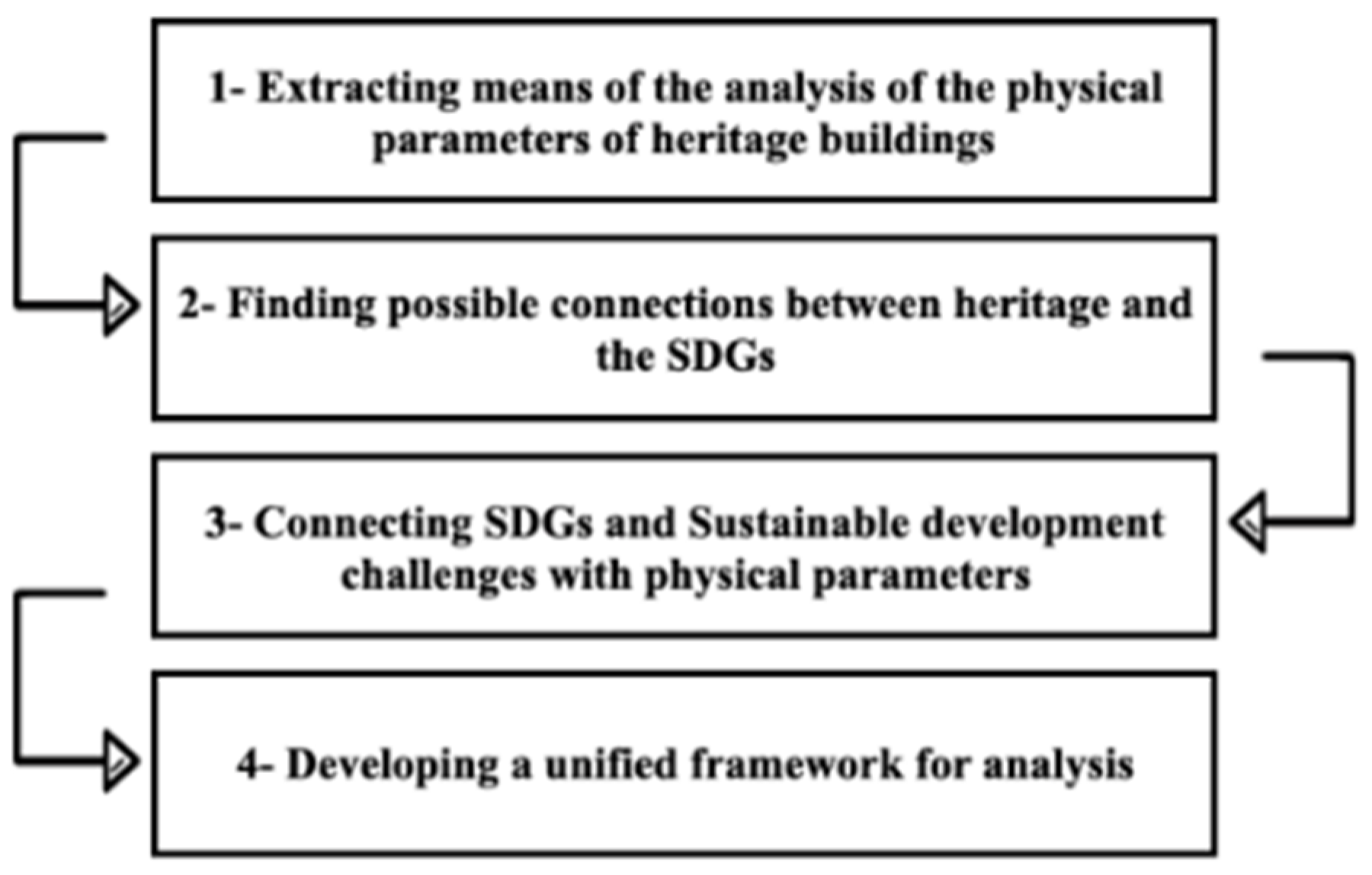
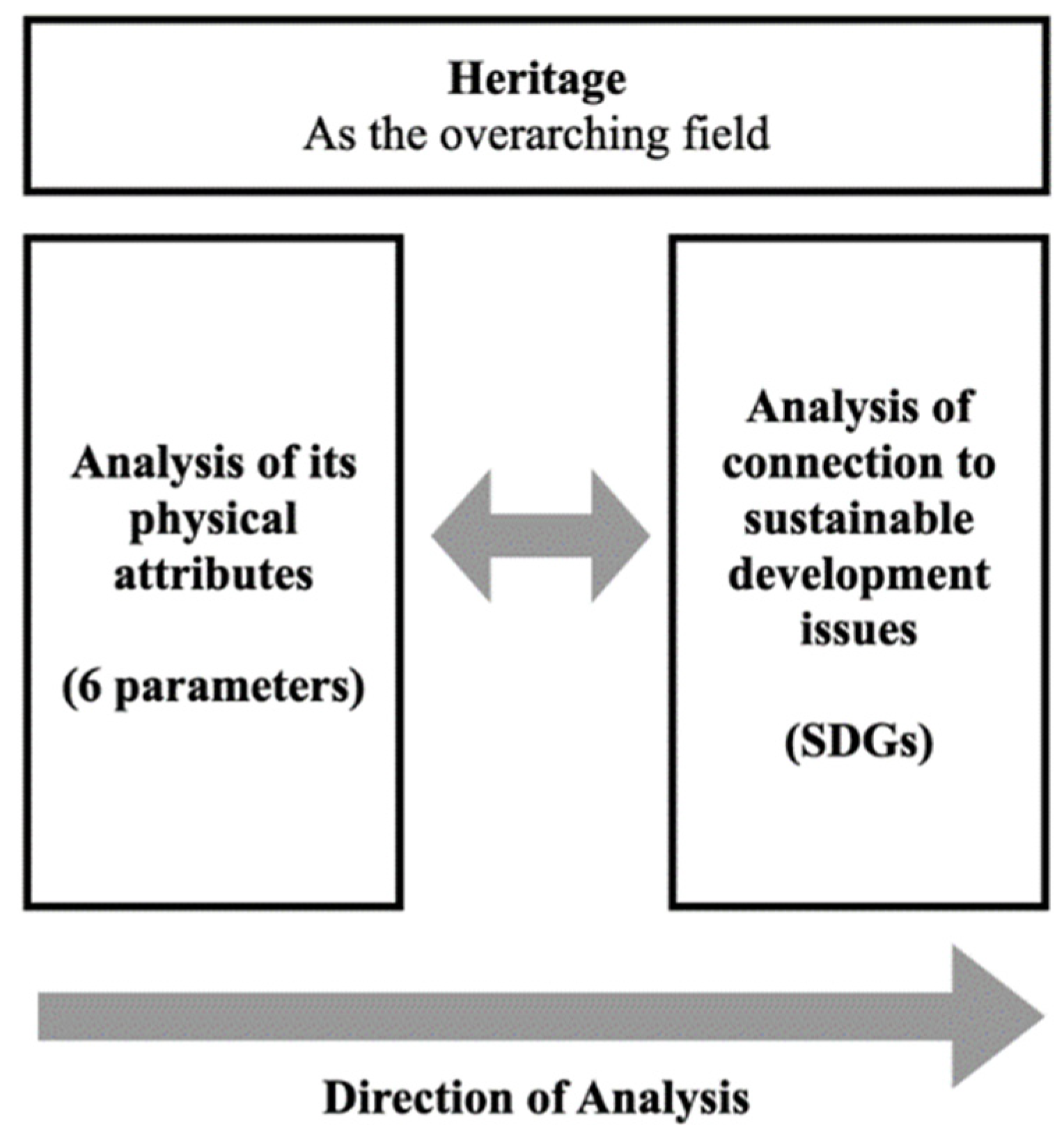
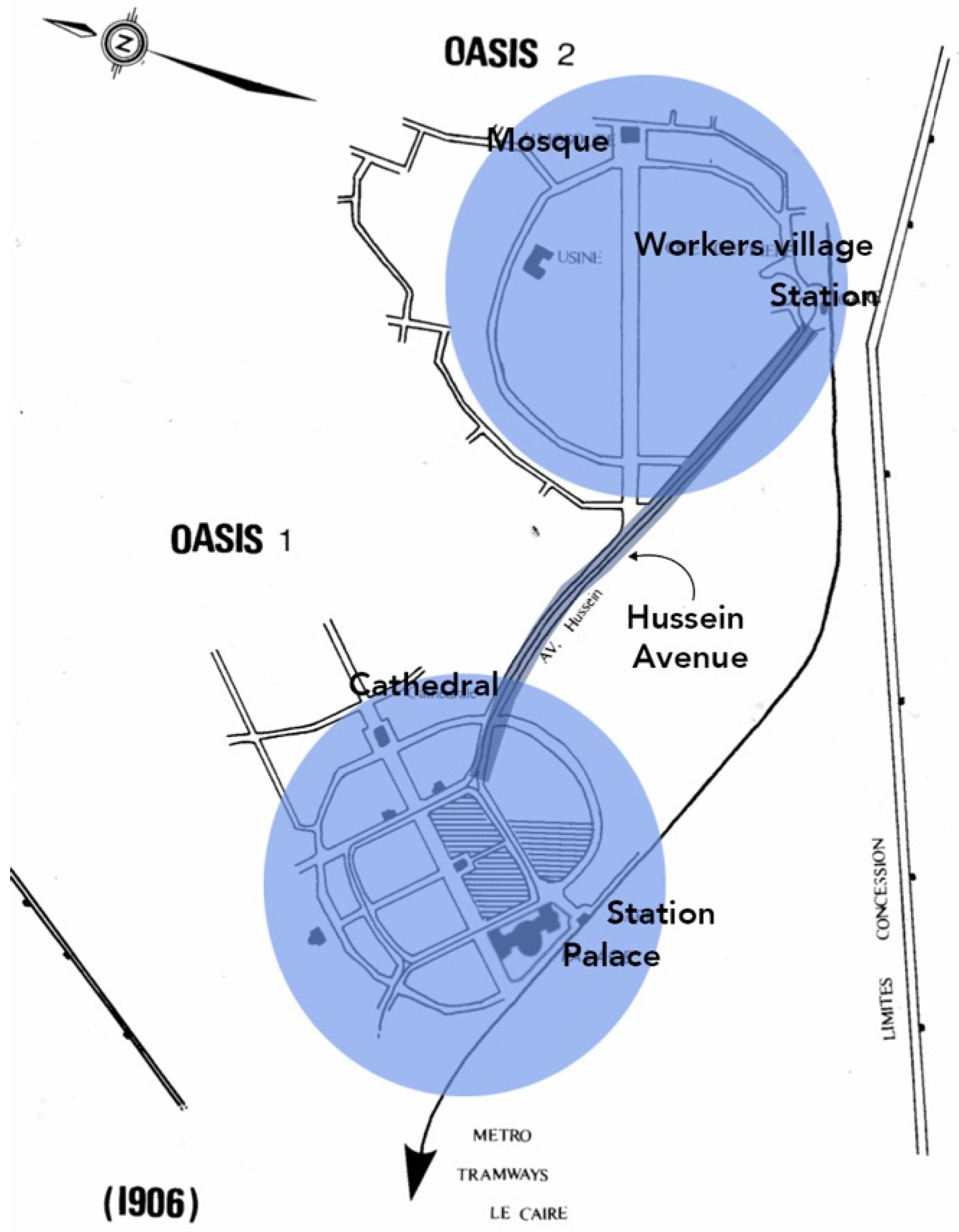
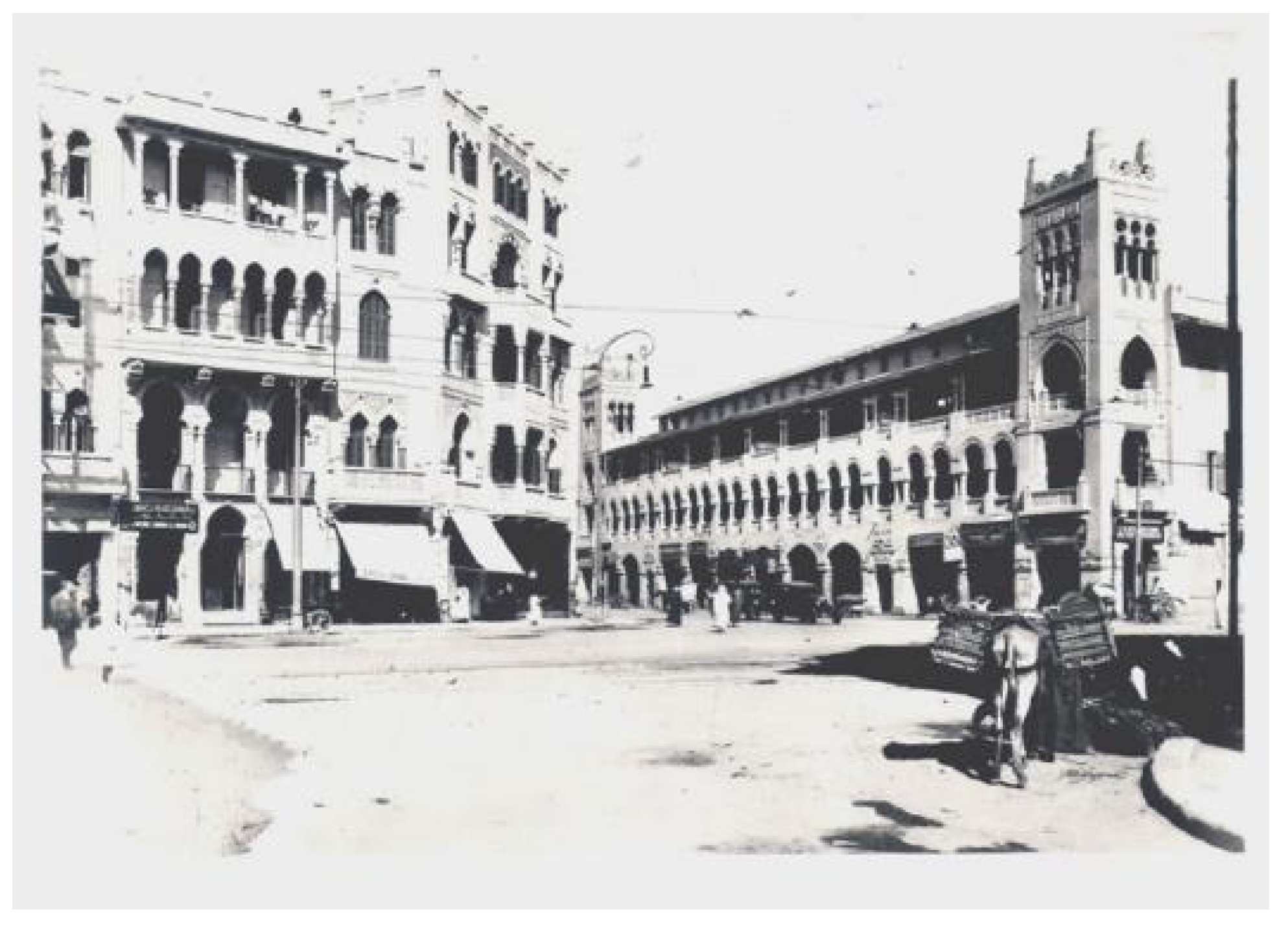
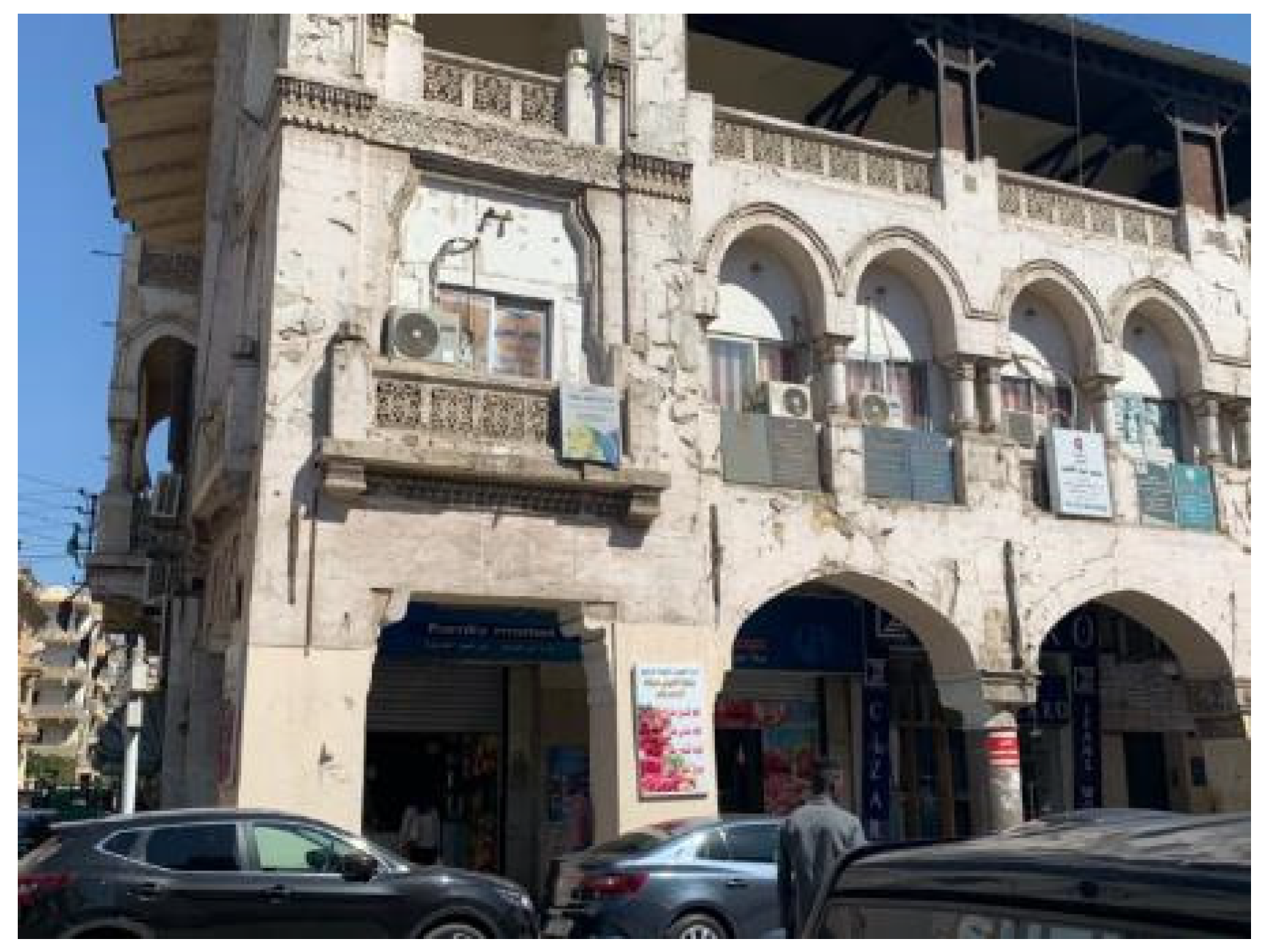
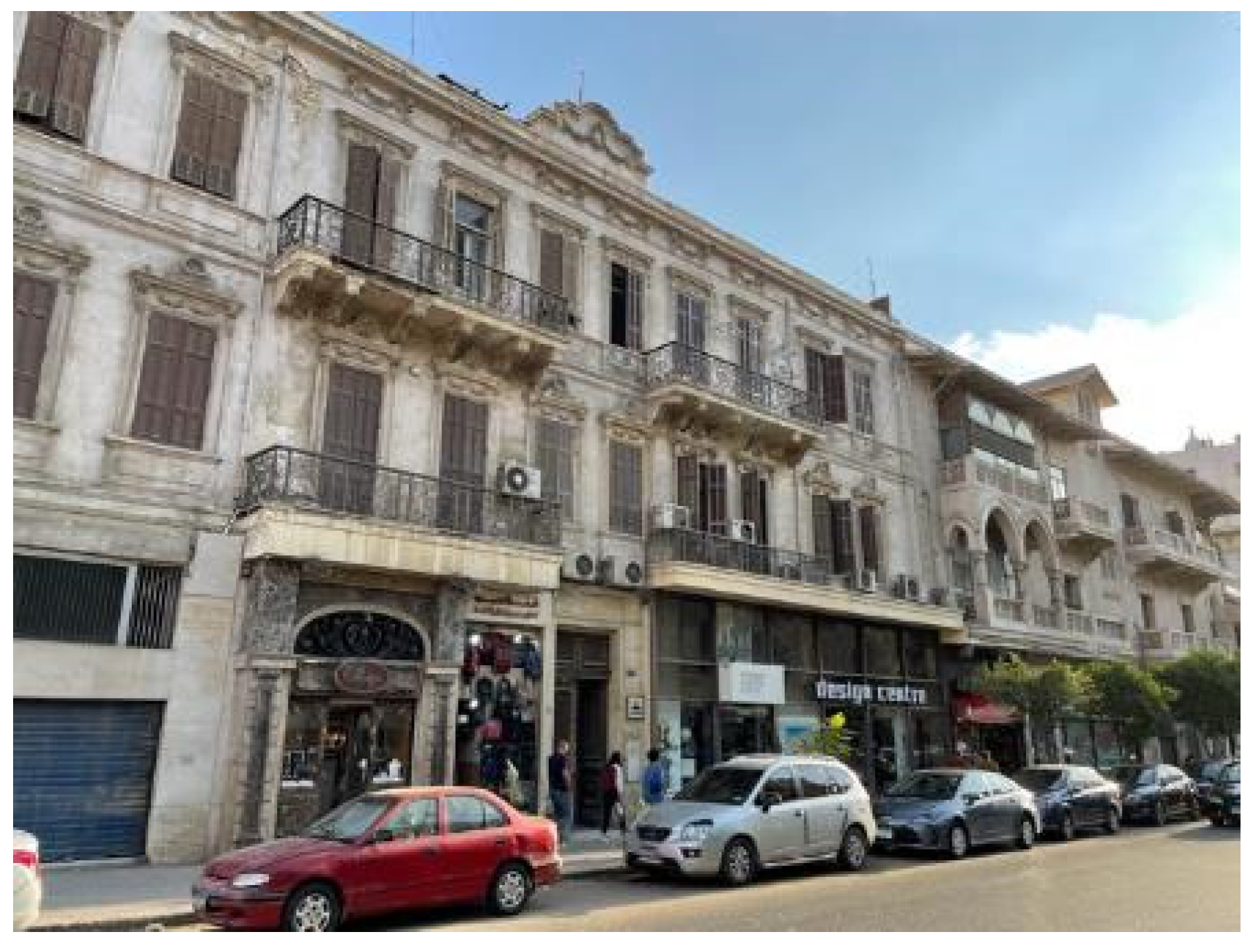
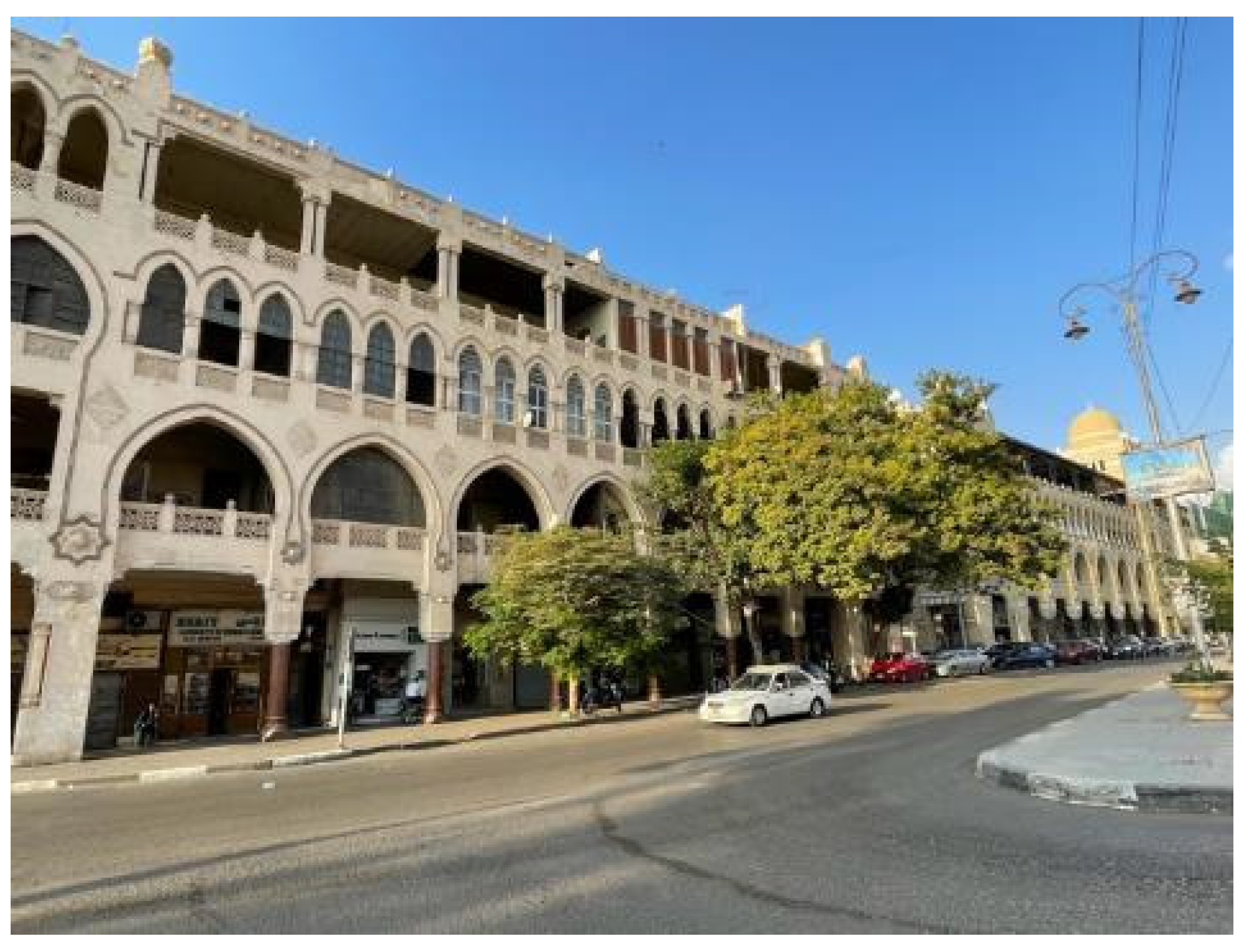
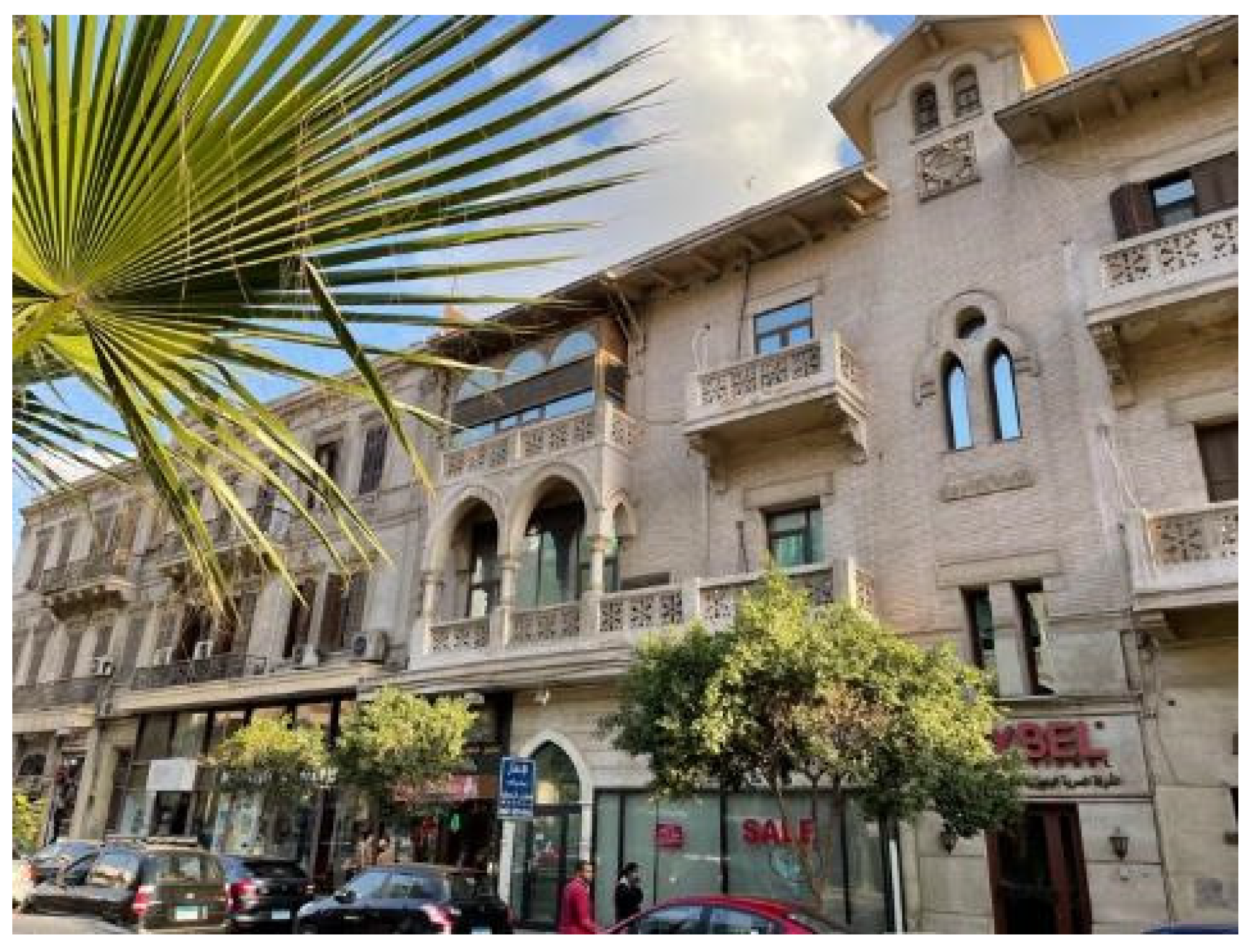
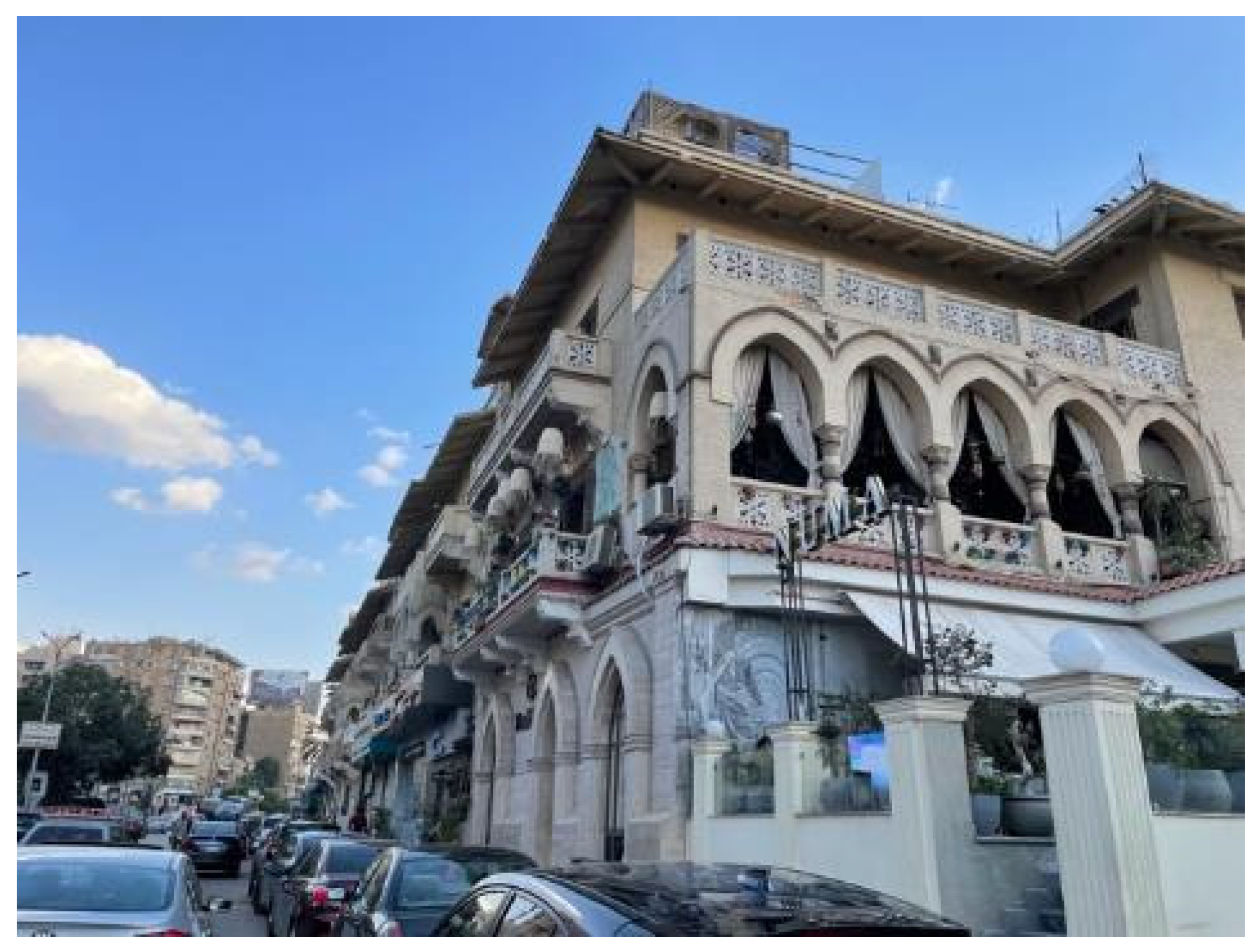
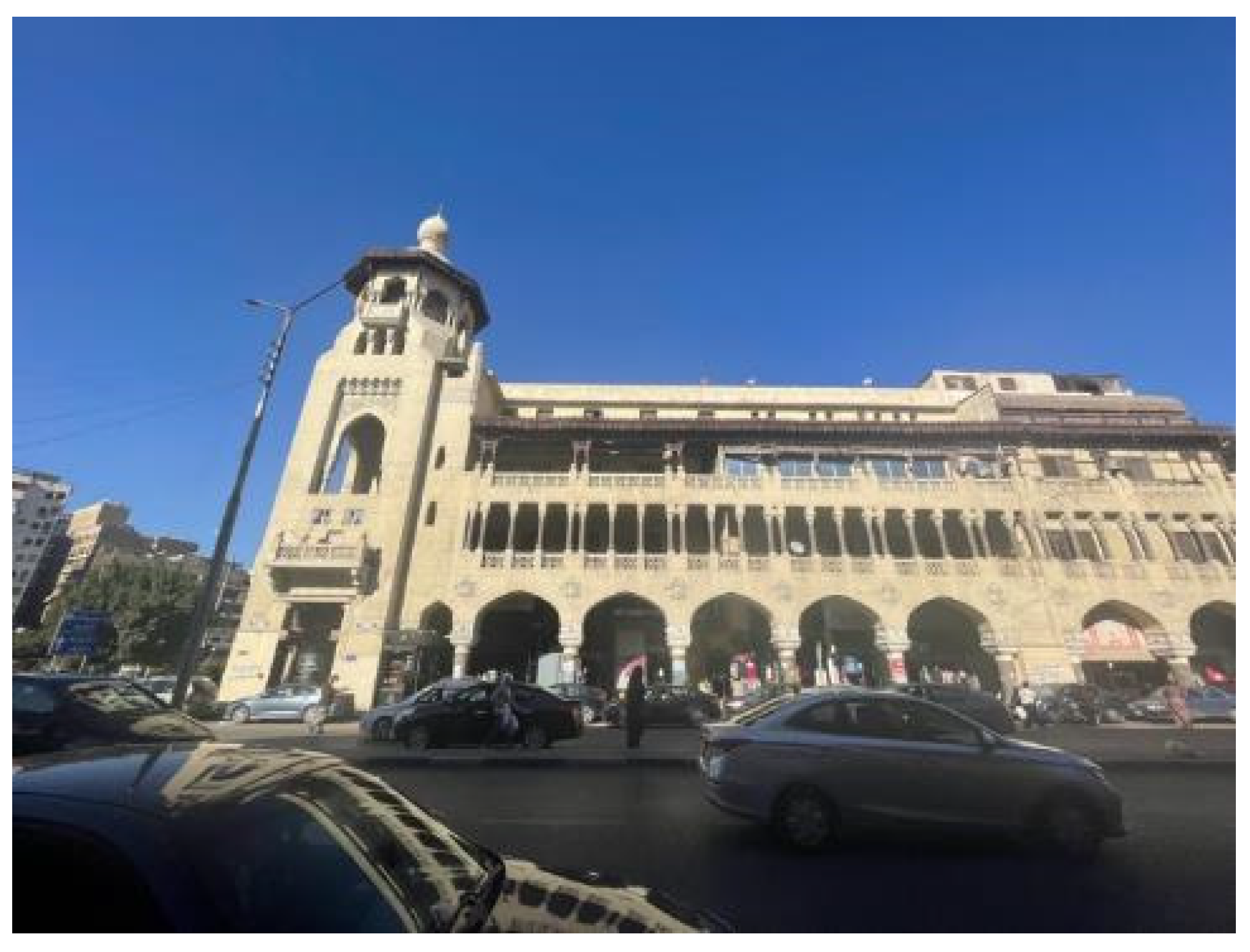

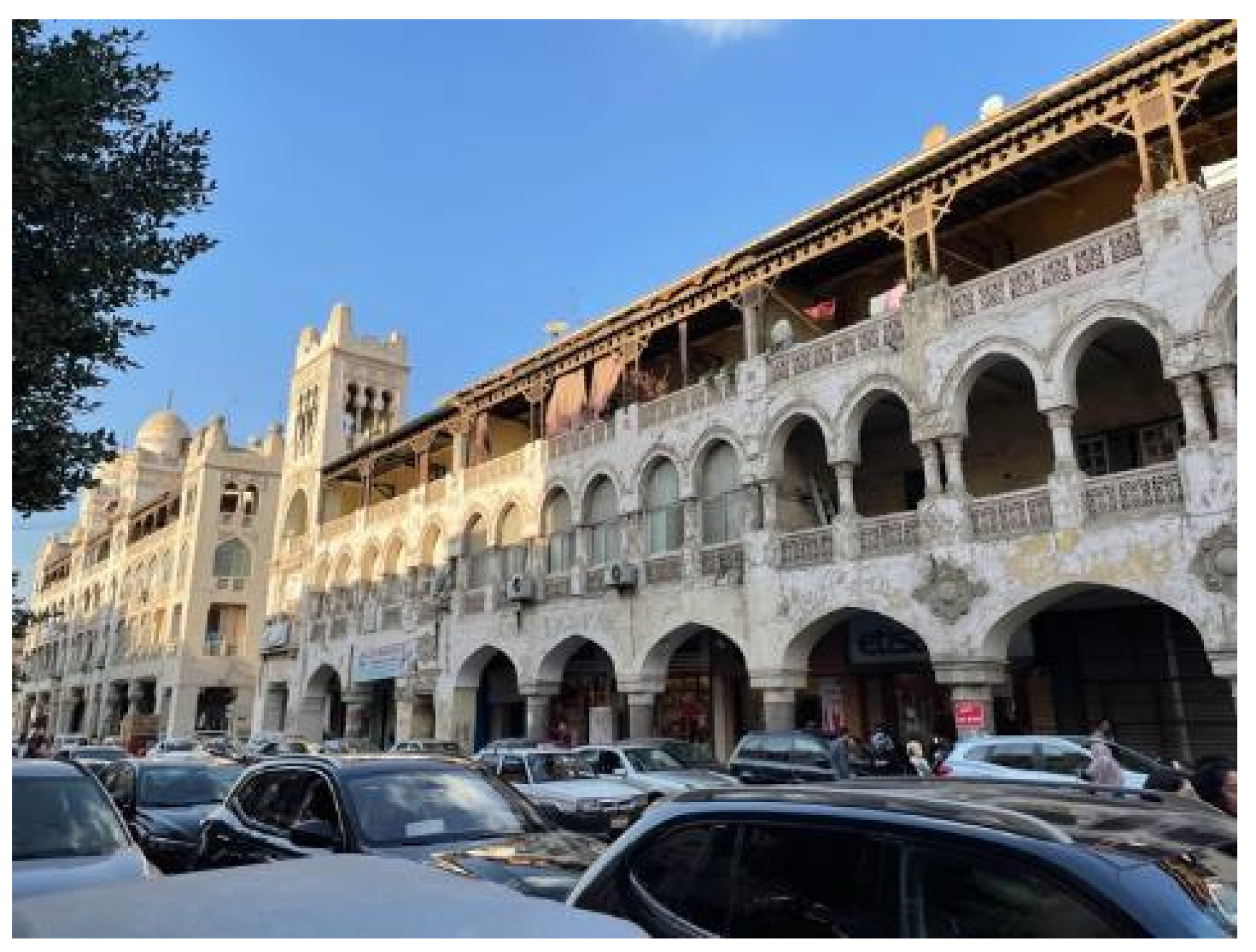
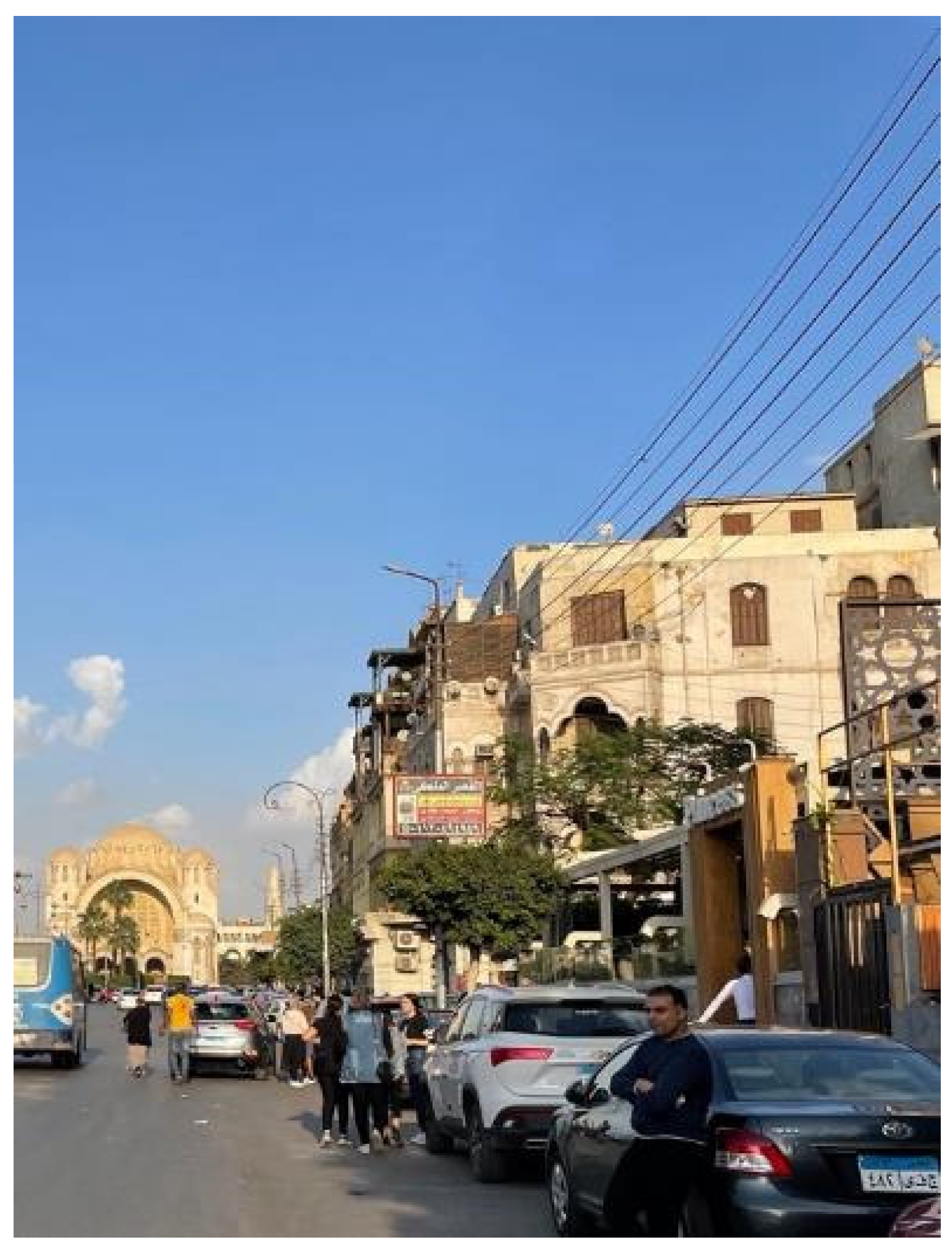
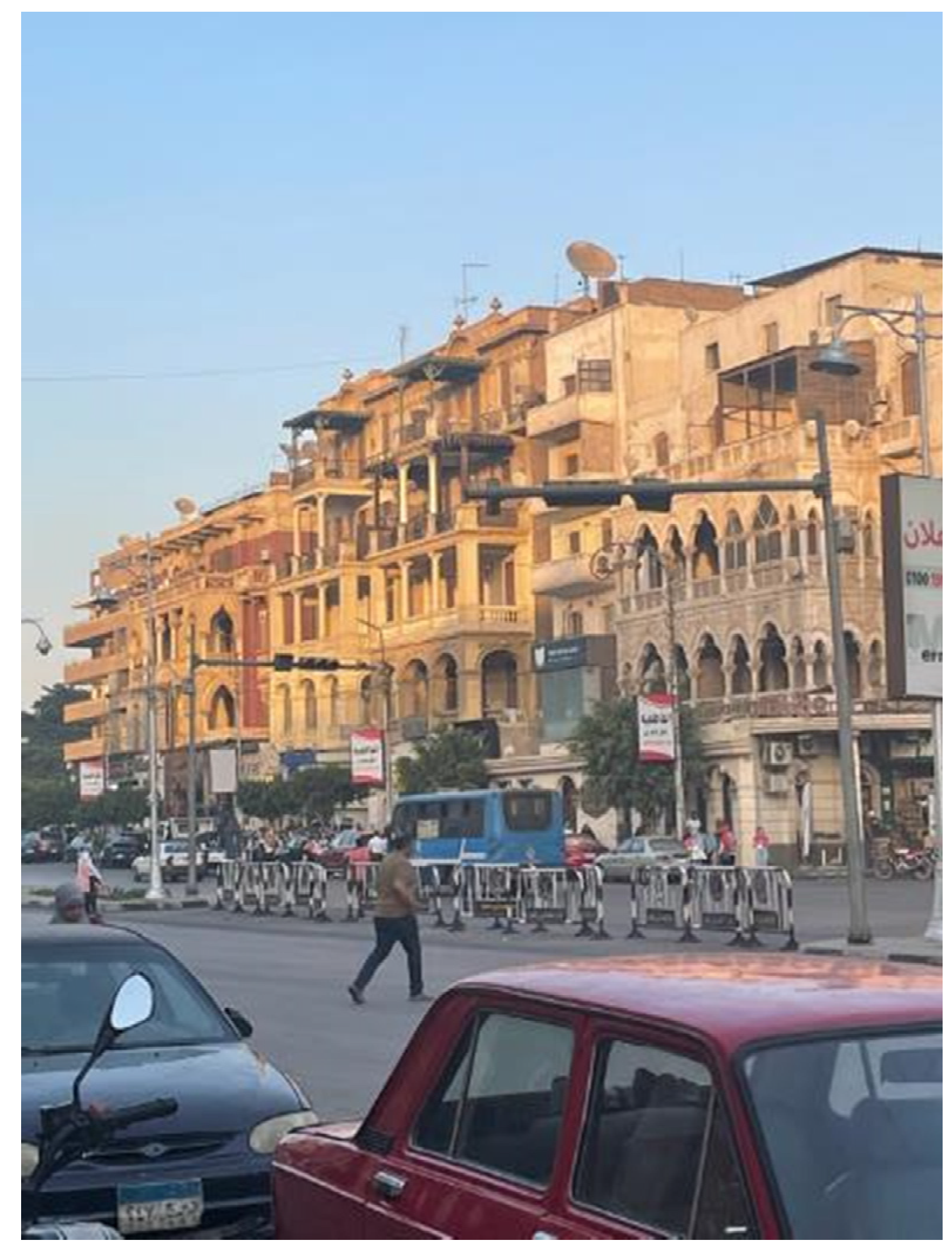
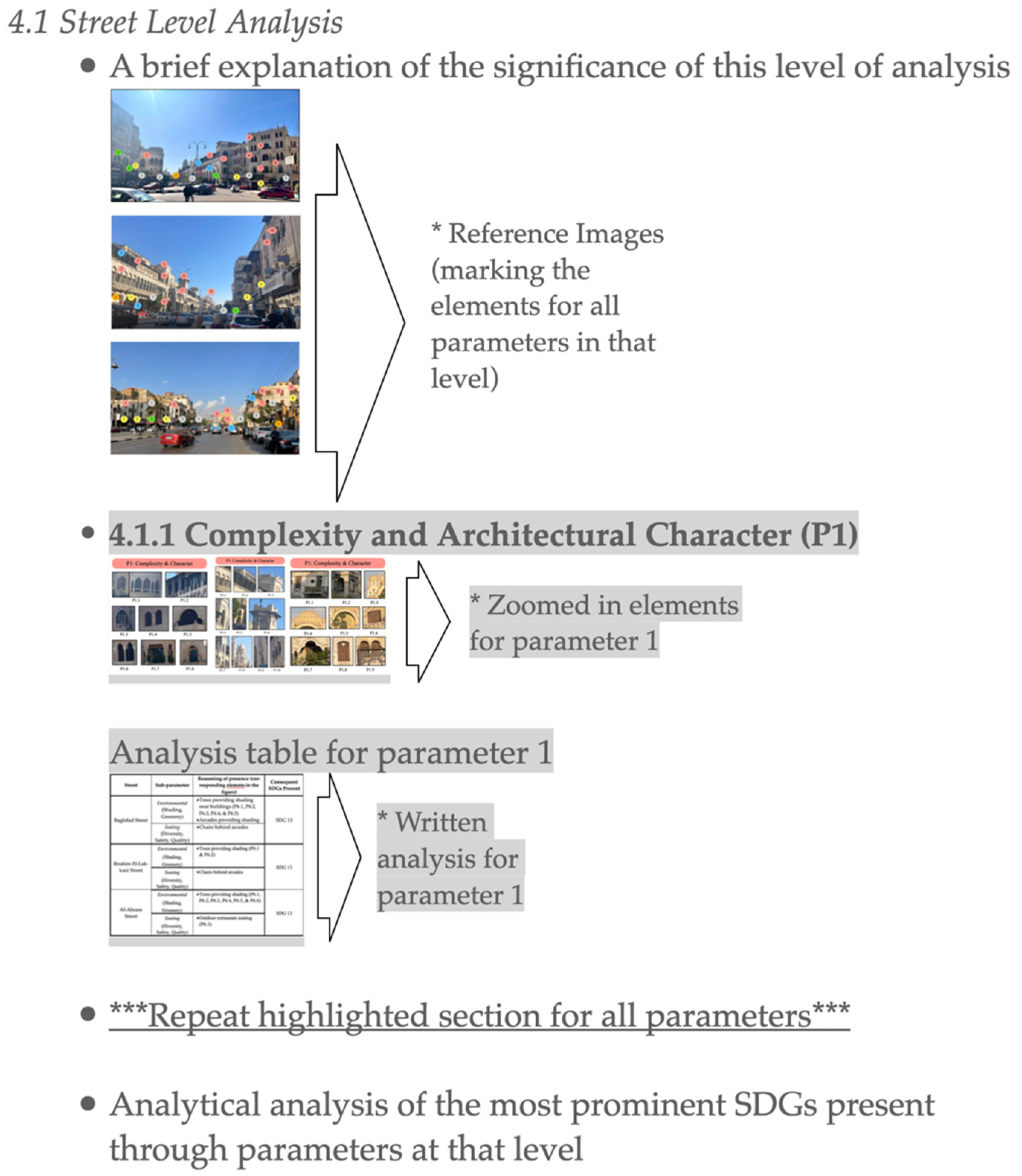
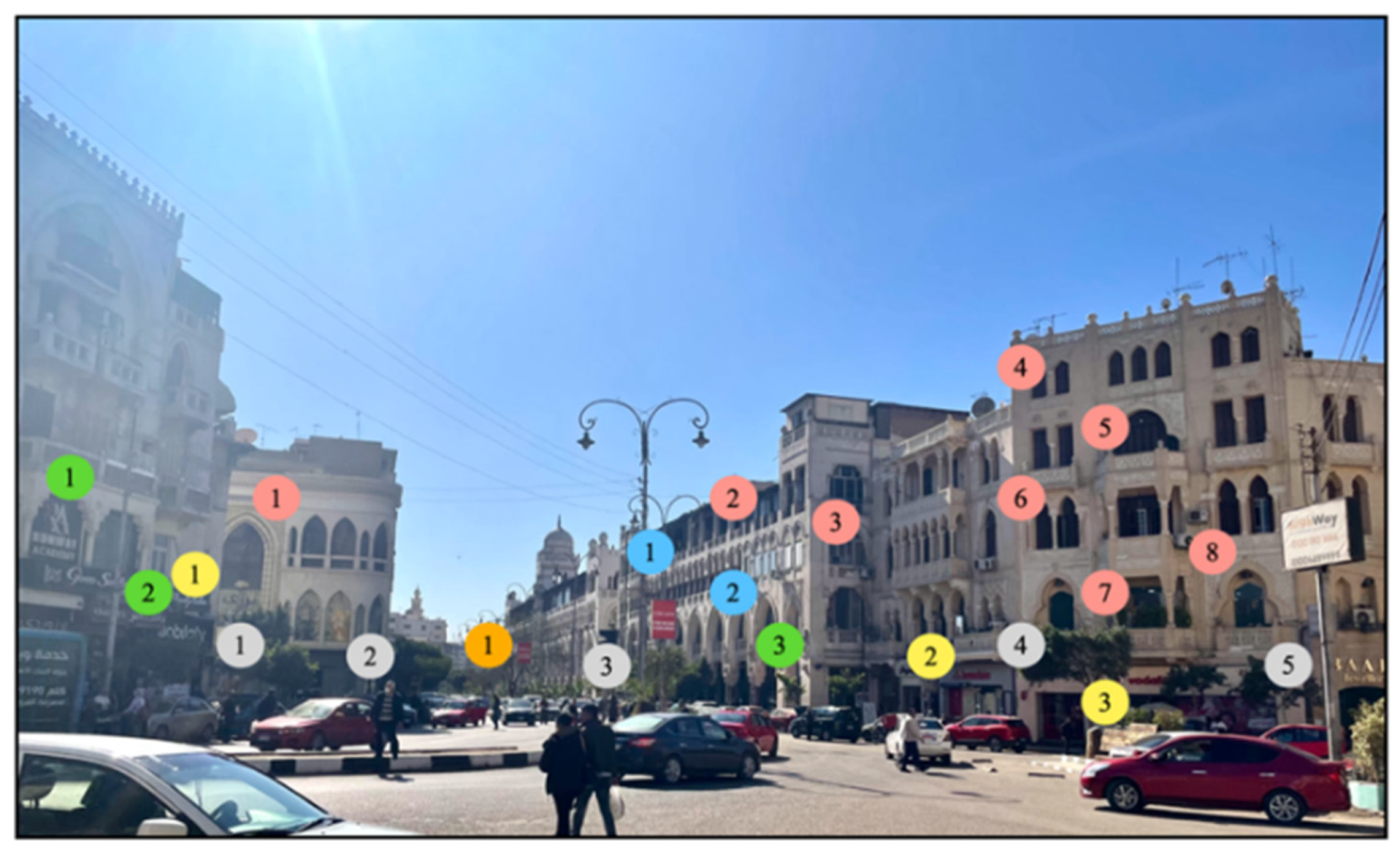
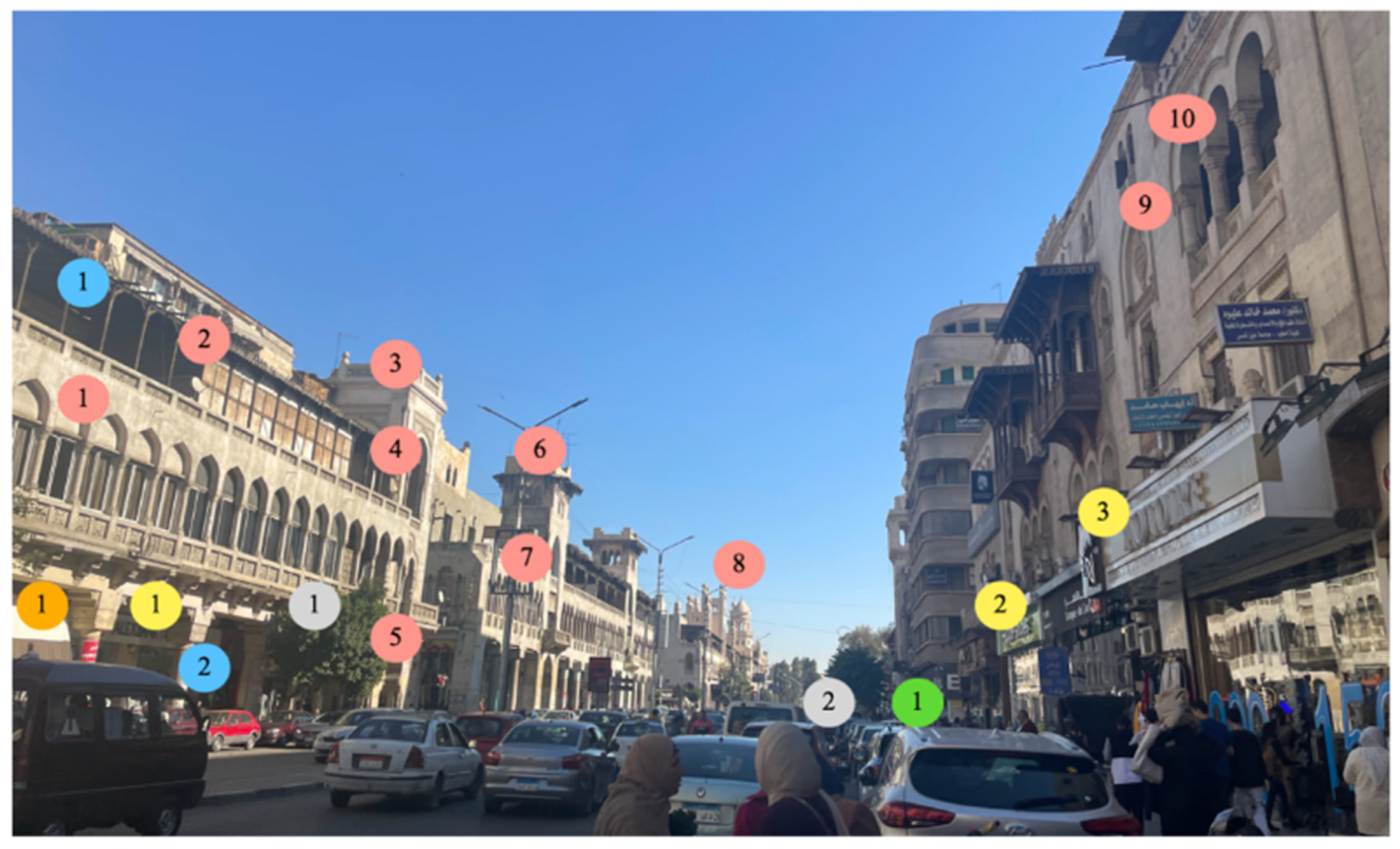
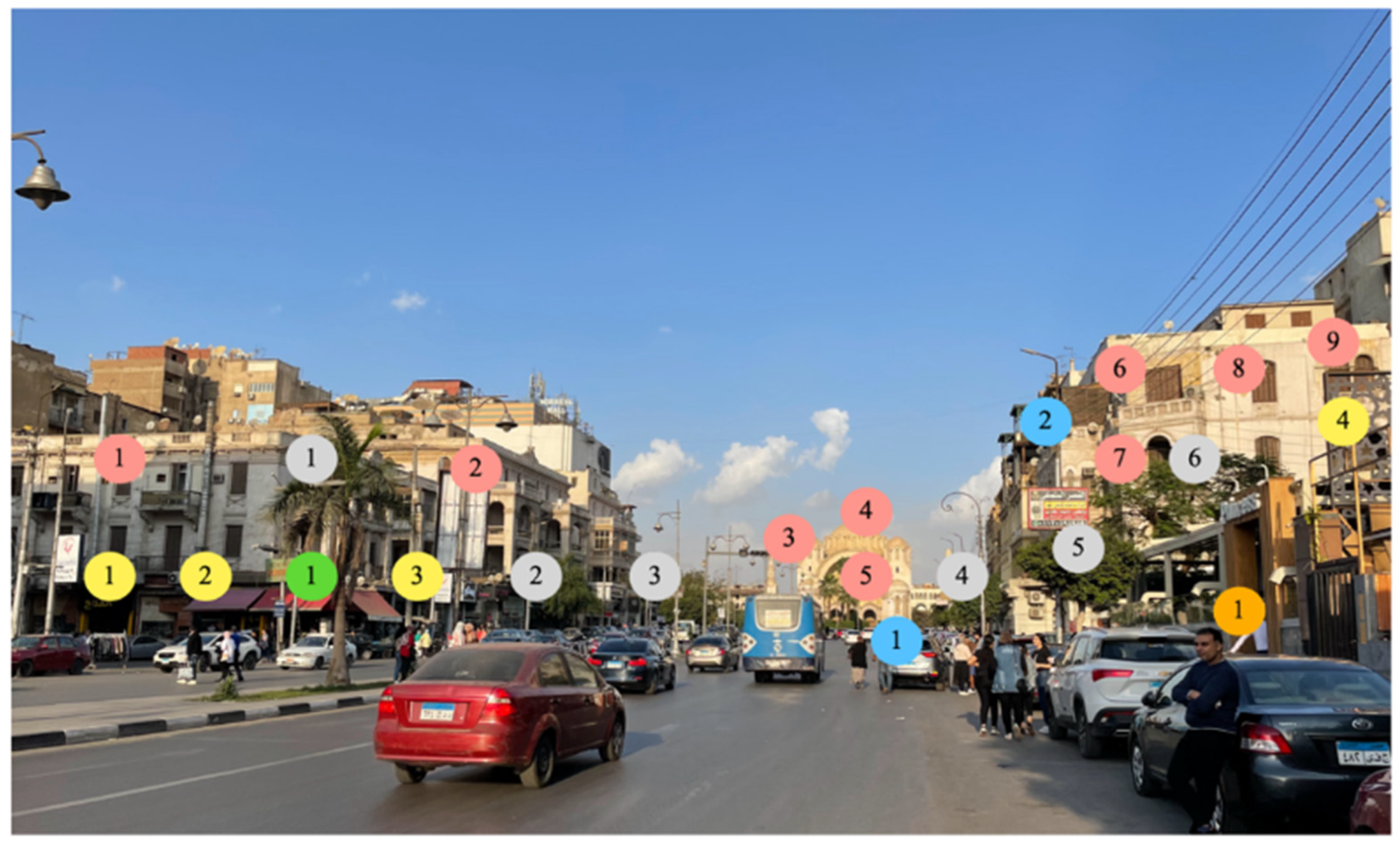
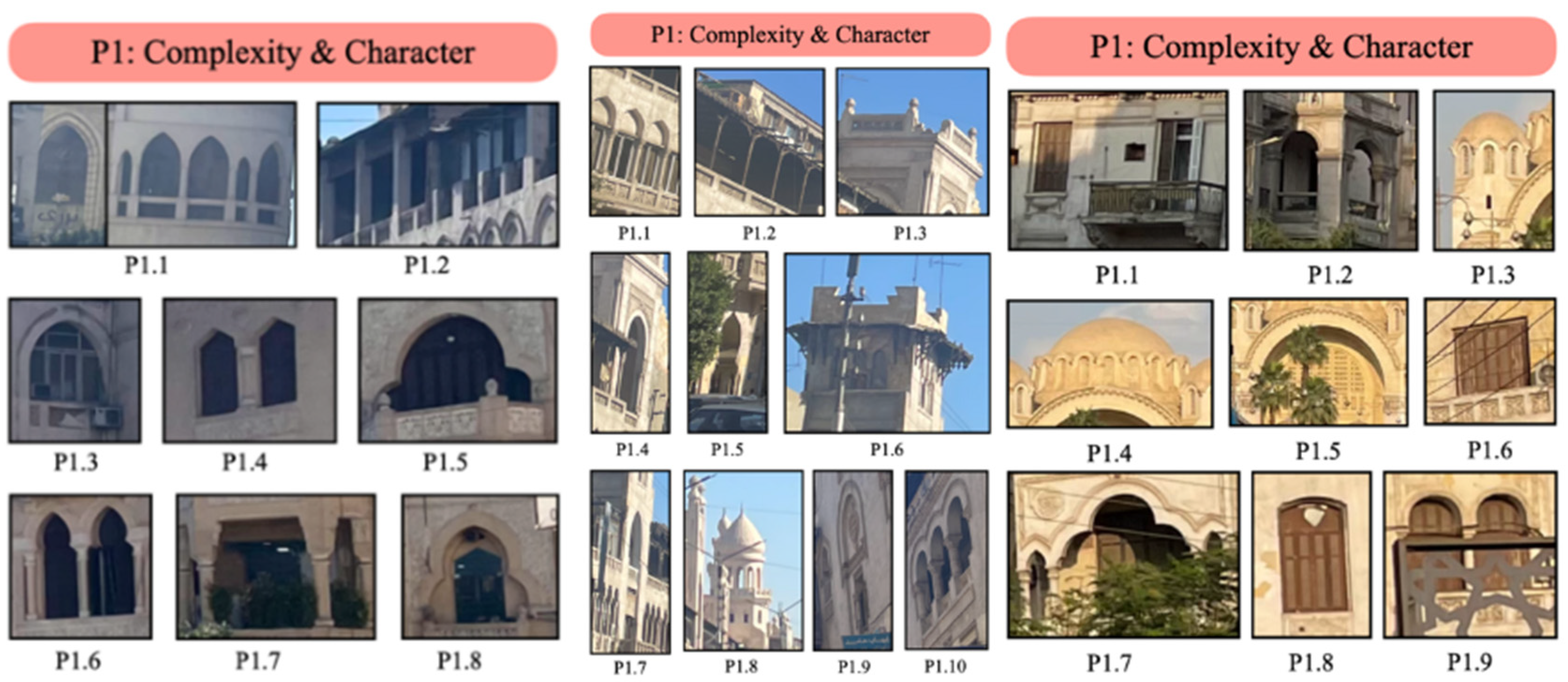





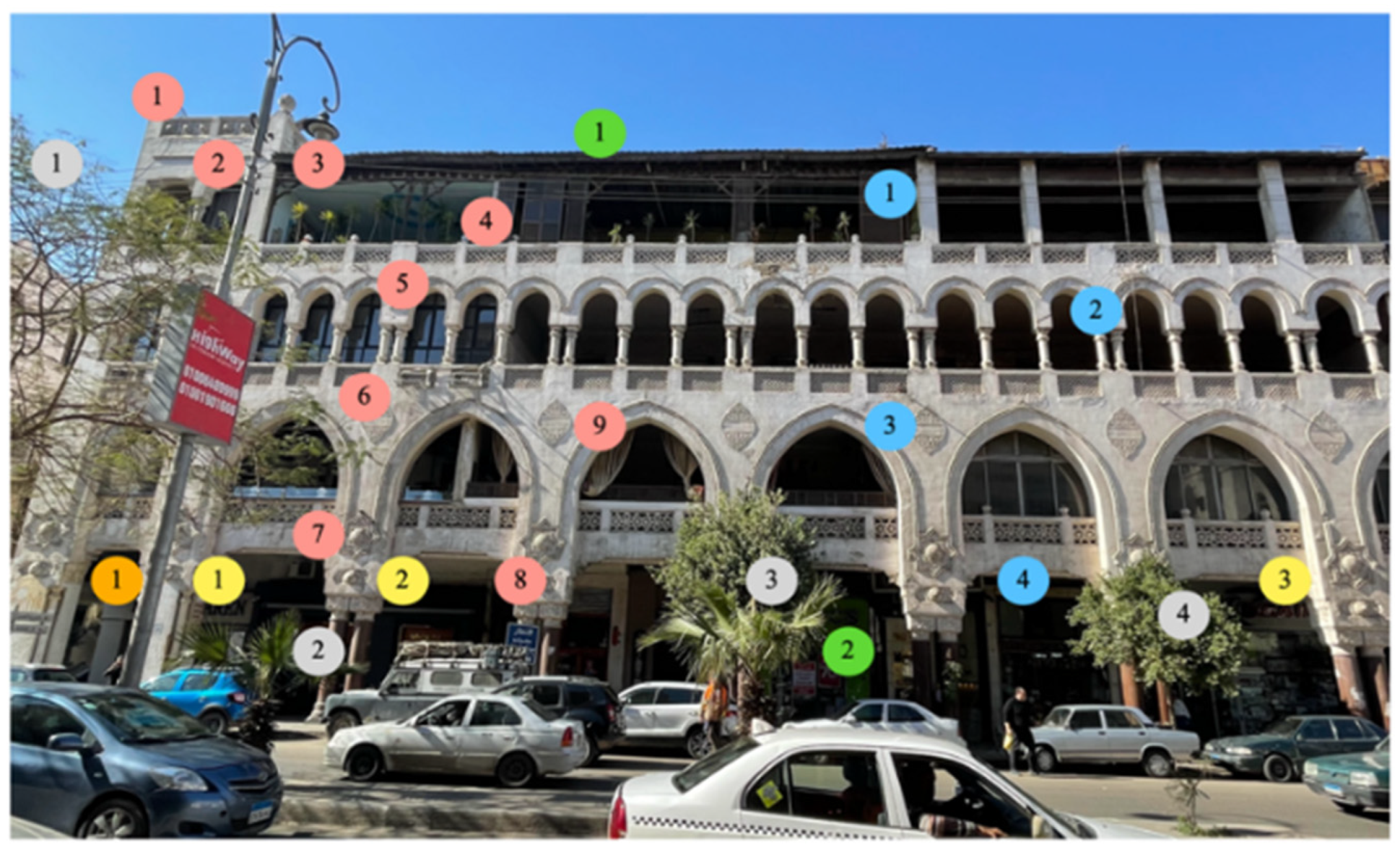
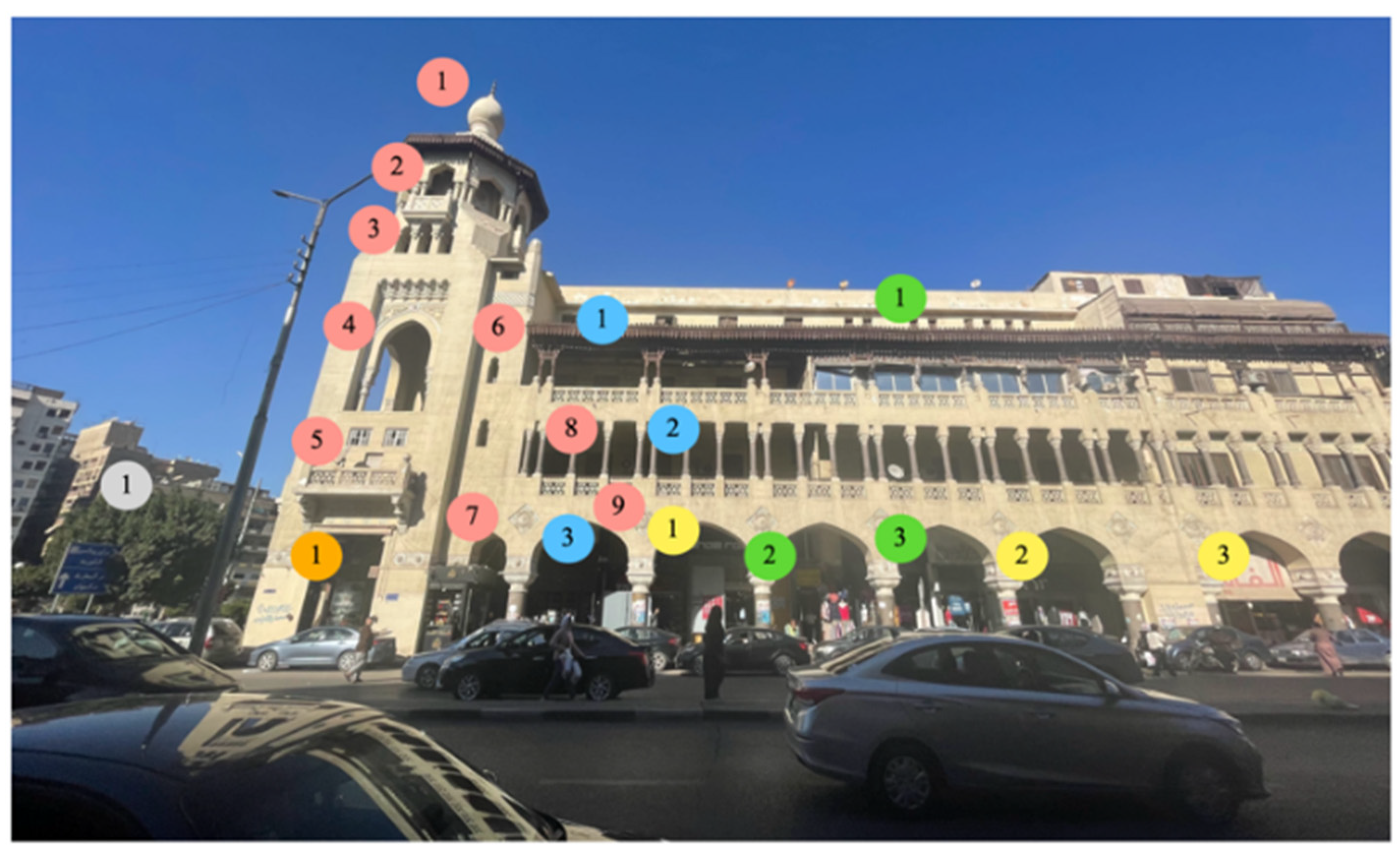
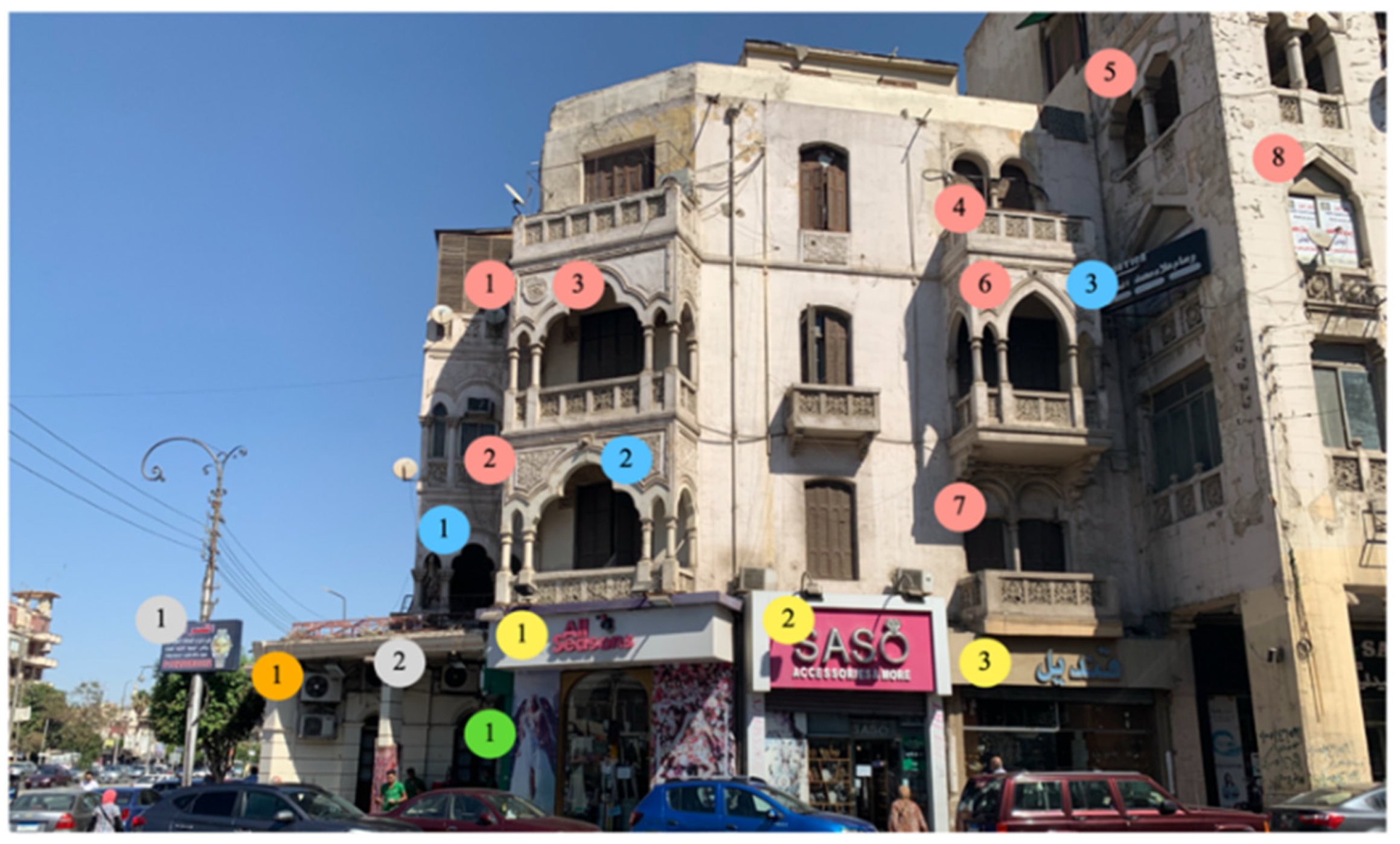
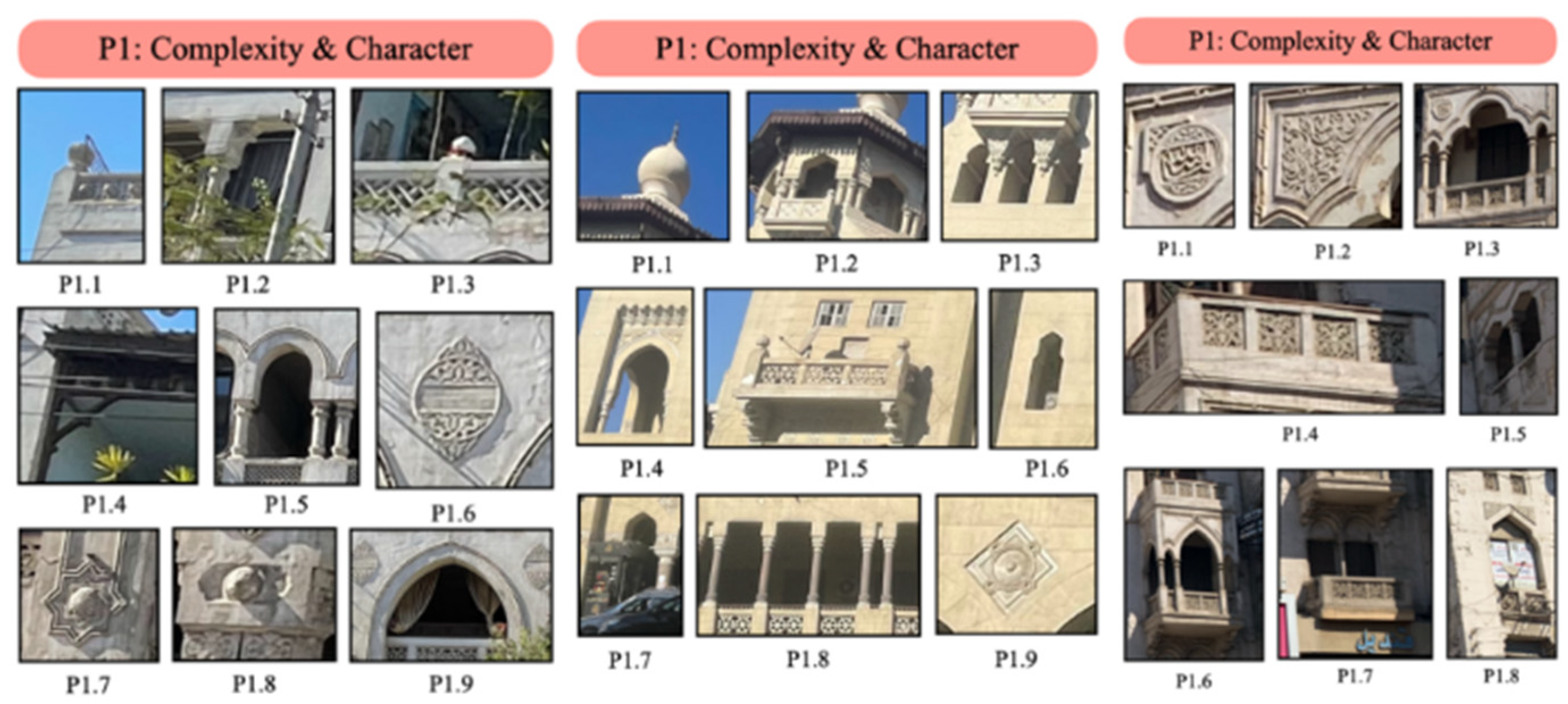





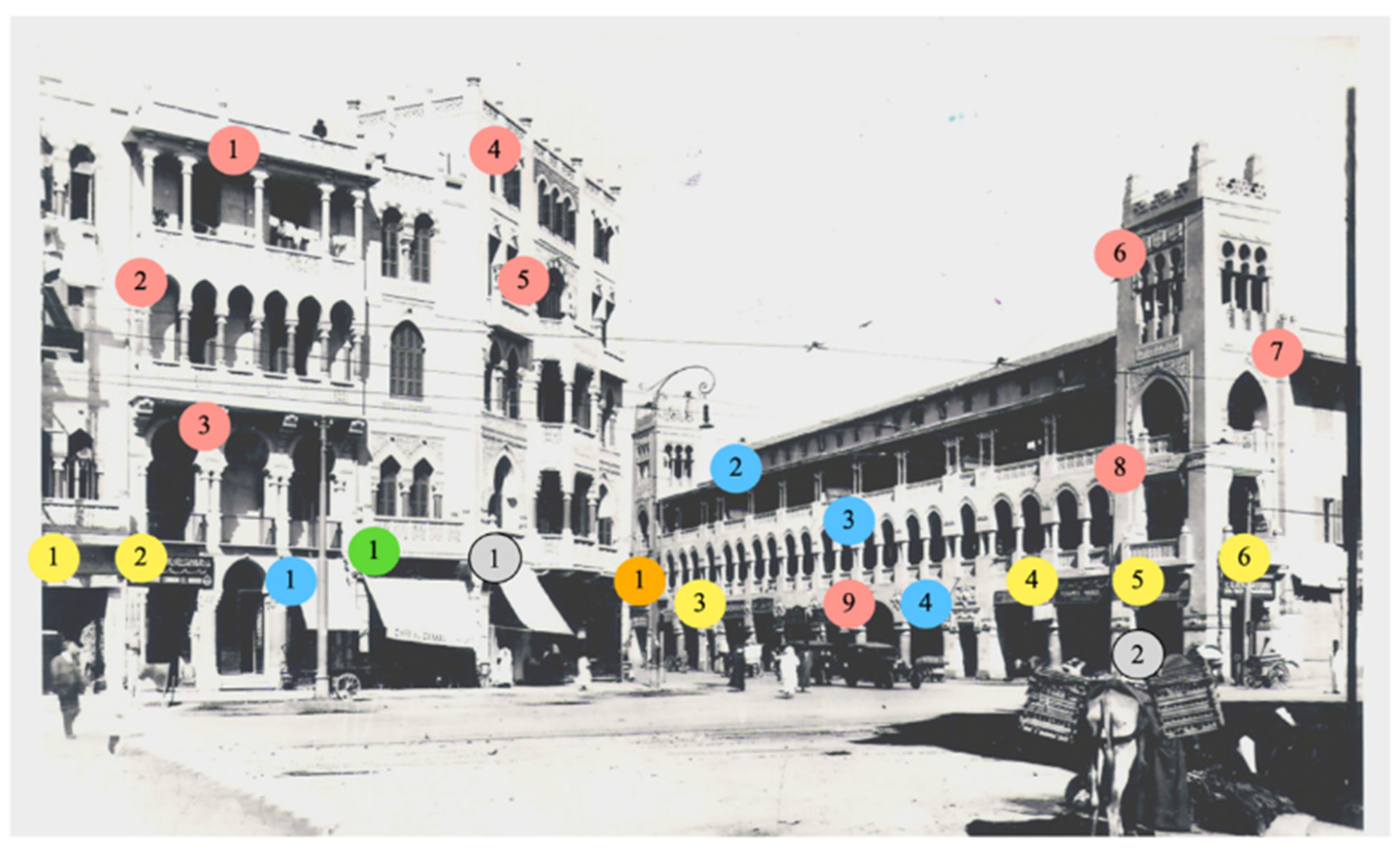
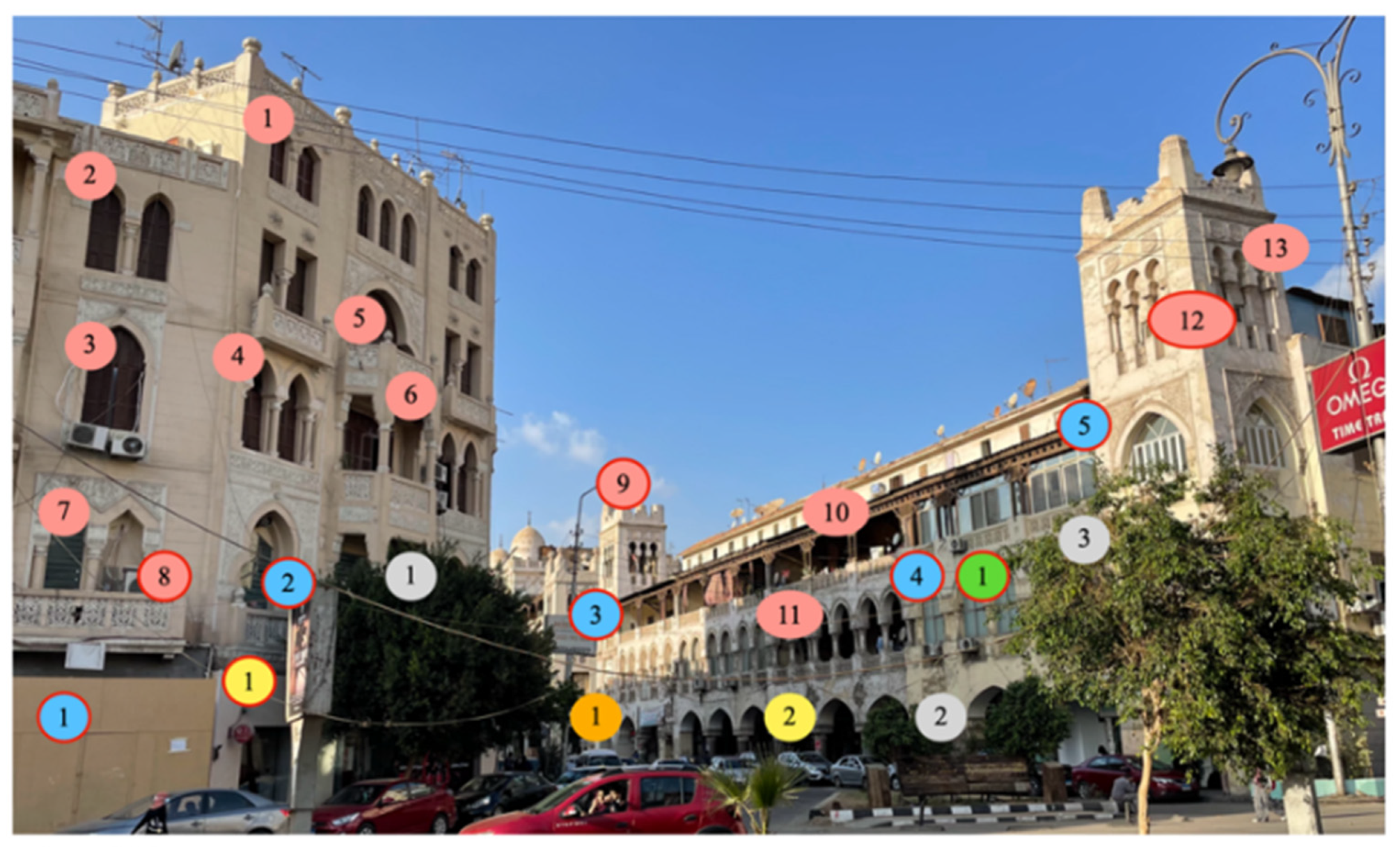
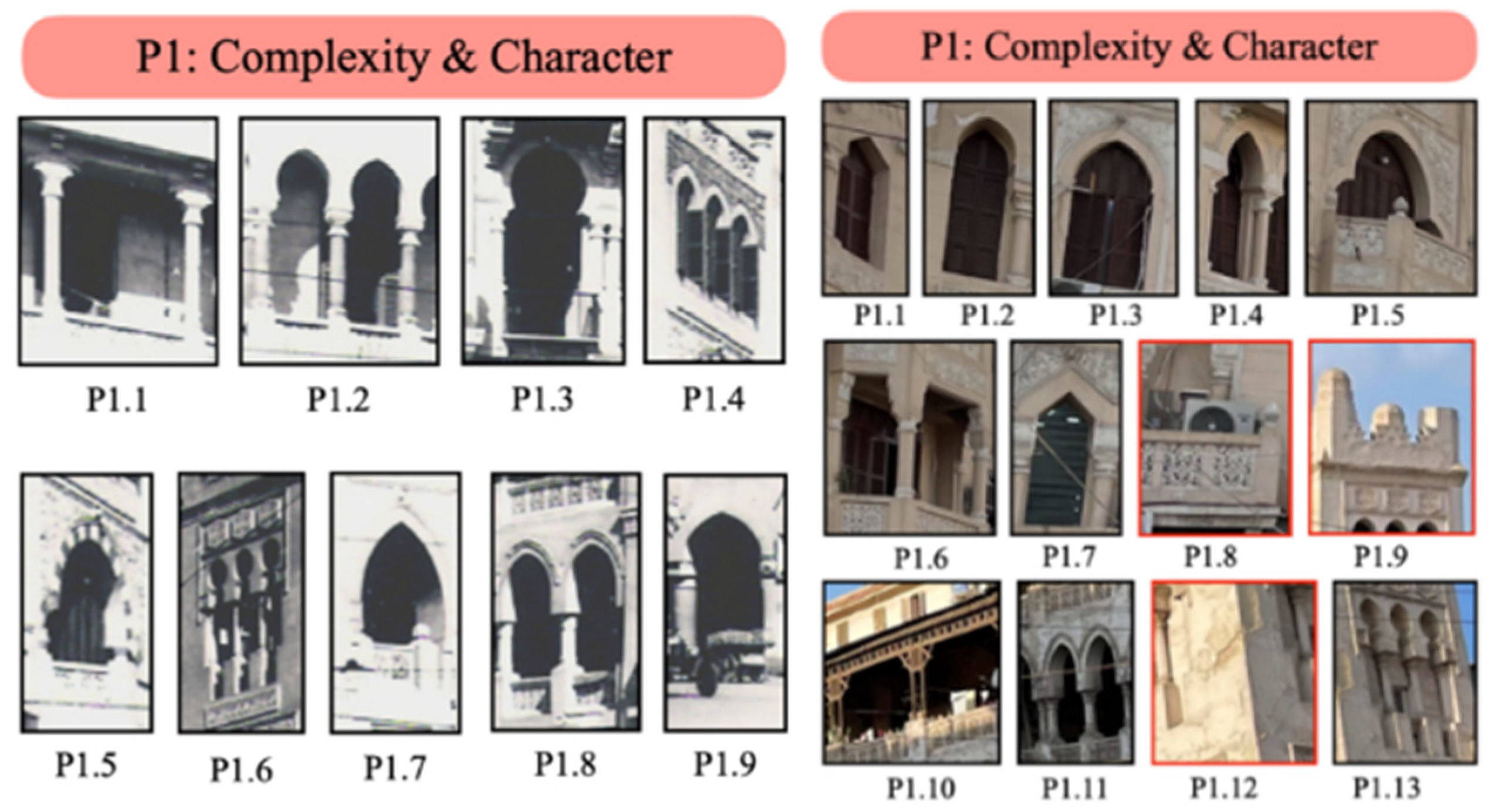
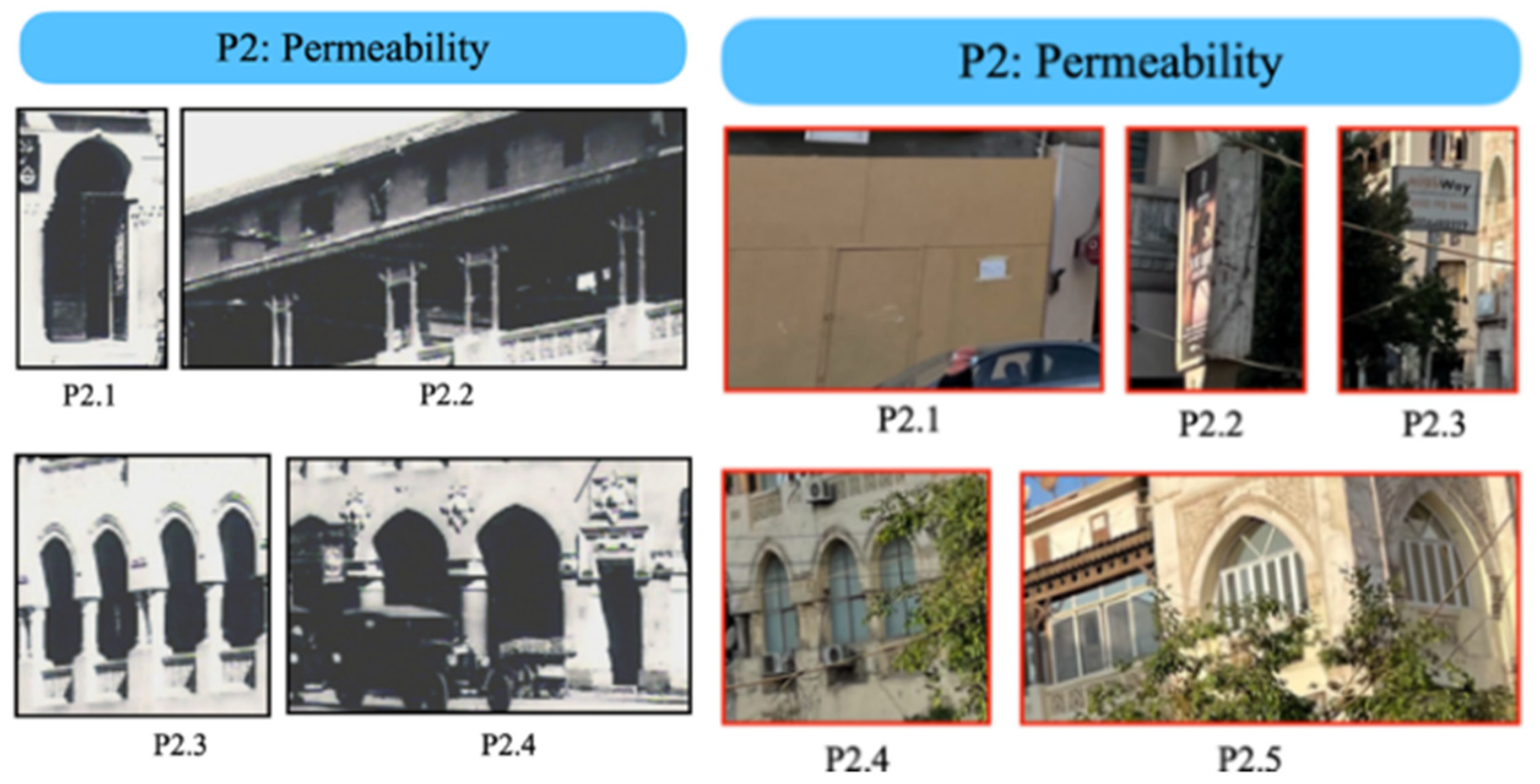




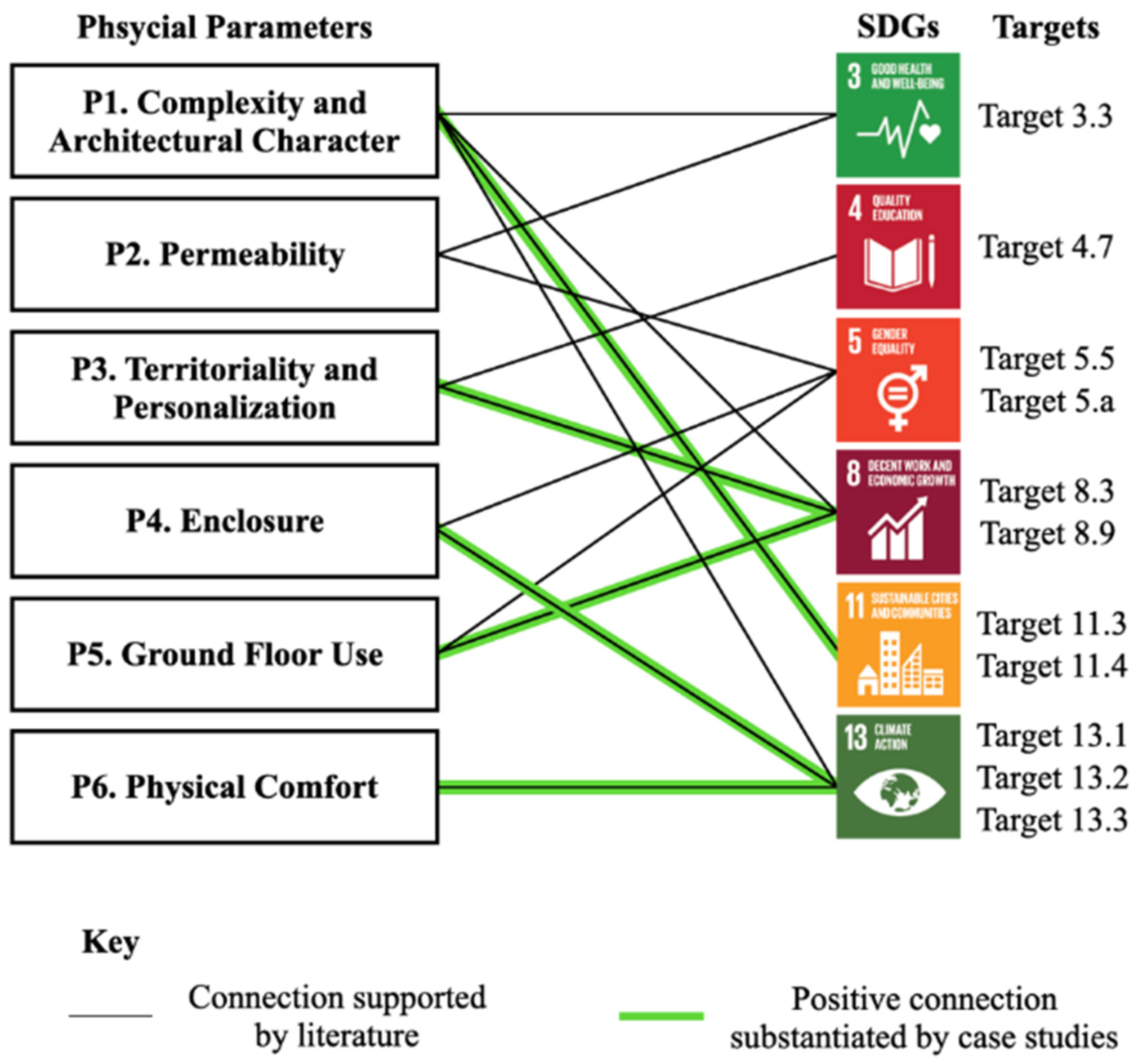
| Relevant SDG | Specific Links | Supporting References |
|---|---|---|
| Goal 3. Ensure healthy lives and promote wellbeing for all at all ages. | There is a direct link between the transmission of infectious and non-communicable diseases and active neighborhoods. However, mitigation techniques are possible. In addition, improved quality of life for residents is linked to local materials. The preservation of historic buildings made with local materials and can aid in the achievement of this SDG. | Adlakha & Sallis [35] Omer & Noguchi [15] |
| Goal 4. Ensure inclusive and equitable quality education and promote lifelong learning opportunities for all. | There is a link between the increase in investment in education (and publicity) related to cultural heritage and the overall conservation of said heritage. | Wang et al. [36] |
| Goal 5. Achieve gender equality and empower all women and girls. | Increasing factors of safety and inclusion in the built environment can increase the role of women in said environment. These include, but are not limited to, increase in line of sight, increased lighting, enclosure, diversity of activity in ground-floor usage etc. Acts of occupying public spaces and streets by street vendors strengthen and encourage the presence and participation of women, and leads to the displaying of their products that are the result of ICH practices. | Salih [37] Darshini & Saumya [38] Shihan, Mariana & Gregory [39] |
| Goal 8. Promote sustained, inclusive, and sustainable economic growth, full and productive employment, and decent work for all. | The parallel between World Heritage Sites (WHS) and tourism is demonstrated via the sources presented. Tourism directly impacts multiple factors in the built environment, such as ground-floor usage and promoting economic growth on site. Furthermore, WHS must possess unique architectural value and a personalized social dynamic and atmosphere. The interplay of the above factors increase tourism and thus promote sustainable economic growth on site. | Scheyvens & Cheer [40] Hosseini, Stefaniec & Hosseini [41] Gholitabar, Alipour & Costa [42] |
| Goal 11. Make cities and human settlements inclusive, safe, resilient, and sustainable. | The hindering of deterioration of the architectural elements present in historical sites can directly increase the cultural heritage value of the place and thus aid in the achievement of this SDG. Creating and preserving sustainable communities that are a derivative of sustainable building materials helps achieve this SDG as it helps protect natural resources. | Chalkidou et al. [15,43] Omer & Noguchi [15] |
| Goal 13. Take urgent action to combat climate change and its impacts. | Preserving historical sites and sustaining their activities (social, economic, and cultural) reduces the demand for new buildings, which helps avoid greenhouse gas emissions. Controlling urban densification creates more room for green spaces and the preservation of trees on site, reducing greenhouse gas emissions. | Omer & Noguchi [15] Maes et al. [44] |
| SDG | Relevant Targets | Physical Parameter | Synergetic Reasoning |
|---|---|---|---|
| Goal 3. Ensure healthy lives and promote wellbeing for all at all ages. | Target 3.3: By 2030, end the epidemics of AIDS, tuberculosis, malaria, and neglected tropical diseases, and combat hepatitis, water-borne diseases, and other communicable diseases. | P2. Permeability | Permeability: Avoiding the transmission of infectious and non-communicable diseases requires mitigation techniques, including openings and multiple walkable routes to a select destination. This can decrease unwanted human contact, making it a synergetic relationship between the parameter and the SDG. |
| P1. Complexity and architectural character | Complexity and architectural character: Ornamentation (and building typologies in general) produced by local materials improve the quality of life for local residents. Protecting these typologies from deterioration lies in synergetic reasoning with this SDG. [35] | ||
| Target 3.9: By 2030, substantially reduce the number of deaths and illnesses from hazardous chemicals and air, water, and soil pollution and contamination. | P1. Complexity and architectural character | Complexity and architectural character: Ornamentation (and building typologies in general) produced by local materials and vernacular techniques improve the quality of life for local residents. The use of common unsustainable building materials (e.g., concrete and bricks) emits hazardous byproducts that harm residents in the long run. Protecting these typologies from deterioration prevents the use of unsustainable building materials and thus lies in synergetic reasoning with this SDG. [35] | |
| Goal 4. Ensure inclusive and equitable quality education and promote lifelong learning opportunities for all. | Target 4.7: By 2030, ensure that all learners acquire the knowledge and skills needed to promote sustainable development, including, among others, through education for sustainable development and sustainable lifestyles, human rights, gender equality, promotion of a culture of peace and non-violence, global citizenship, and appreciation of cultural diversity and of culture’s contribution to sustainable development. | P3. Territoriality and personalization | Territoriality and personalization: The unique interventions of the locals in their physical surroundings, whether tangibly through street vending and other forms of self-expression or intangibly through teaching of crafts, is a manner of carrying on knowledge. The preservation of these forms of self-expression, as well as the built environment containing it, is the preservation of this cultural education and leads to publicity for the area; thus, it has a synergetic effect on this SDG. [36] |
| Goal 5. Achieve gender equality and empower all women and girls. | Target 5.2: Eliminate all forms of violence against all women and girls in the public and private spheres, including trafficking and sexual and other types of exploitation. | P2. Permeability P4. Enclosure | Permeability and Enclosure: There is a direct link between increasing variables such as the line of sight and the presence of multiple routes for escape and an increase in women’s feelings of safety. A site with increased permeability and enclosure will promote said feelings of safety. This makes this relationship synergetic with promoting the participation of women in the context’s public spaces and decreases incidents of violence against them. The promotion of facades with the above-mentioned features becomes a major contributor to target 5.2. [37,38] |
| Target 5.5: Ensure women’s full and effective participation and equal opportunities for leadership at all levels of decision-making in political, economic, and public life. | P2. Permeability P4. Enclosure | Permeability and Enclosure: There is a direct link between increasing variables such as the line of sight and the presence of multiple routes for escape and an increase in women’s feelings of safety. This makes this relationship synergetic with promoting the participation of women in the area’s economic life. | |
| Target 5.a: Undertake reforms to give women equal rights to economic resources, as well as access to ownership and control over land and other forms of property, financial services, inheritance, and natural resources, in accordance with national laws. | P5. Ground-floor use | Ground-floor use: The presence of diverse ground-floor activities promotes feelings of safety for women passing by and thus increases their economic participation in the area. In addition, the phenomenon of women street vendors is a direct enhancement to SDG 5. [37,38,39] | |
| Goal 8. Promote sustained, inclusive, and sustainable economic growth, full and productive employment, and decent work for all. | Target 8.3: Promote development-oriented policies that support productive activities, decent job creation, entrepreneurship, creativity, and innovation, and encourage the formalization and growth of micro-, small-, and medium-sized enterprises, including through access to financial services. Target 8.9: By 2030, devise and implement policies to promote sustainable tourism that creates jobs and promotes local culture and products. | P5. Ground-floor use P3. Territoriality and personalization P1. Complexity and architectural character | The interplay of the following three parameters, ground-floor use, territoriality and personalization, and complexity and architectural character, result in a synergetic link with tourism. Tourism is a significant economic generator in WHS and is increased by authentic ornamentation and shapes, diverse functions in ground-floor shops, and unique interventions from the locals. The protection of this built environment is a major contributor in the sustenance of SDG 8′s achievement in the context. [40,41,42] |
| Goal 11. Make cities and human settlements inclusive, safe, resilient, and sustainable. | Target 11.3: By 2030, enhance inclusive and sustainable urbanization and capacity for participatory, integrated, and sustainable human settlement planning and management in all countries. Target 11.4: Strengthen efforts to protect and safeguard the world’s cultural and natural heritage. | P1. Complexity and architectural character | Complexity and architectural character: The synergetic link between SDG 11 and this parameter lies in two points. Firstly, safeguarding historic architectural elements increases its cultural value, which aligns directly with target 11.4. Secondly, as stated previously, the preservation of locally made ornamentations improves the quality of life for locals and makes the built environment more resilient. [15,43] |
| Goal 13. Take urgent action to combat climate change and its impacts. | Target 13.1: Strengthen resilience and adaptive capacity to climate-related hazards and natural disasters in all countries. Target 13.2: Integrate climate change measures into national policies, strategies, and planning. Target 13.3: Improve education, awareness-raising, and human and institutional capacity on climate change mitigation, adaptation, impact reduction, and early warning. | P1. Complexity and architectural character | Complexity and architectural character: The preservation of the unique architectural identity of historic sites helps curb the demand for new buildings which helps with climate change-related crises, making it synergetic with this SDG. |
| P6. Physical comfort | Physical comfort: The protection of trees on site aids in combating climate change while providing shade and physical comfort to the users, making the preservation of this parameter synergetic with SDG 13. [15,44] |
| Street | Sub-Parameter | Reasoning of Presence (Corresponding Elements in the Figure) | Consequent SDGs Present |
|---|---|---|---|
| Baghdad Street | Ornamentation (Types and Frequency) | Stucco decorations in the arch’s spandrels (P1.5) | SDG 3 SDG 8 SDG 11 SDG 13 |
| Decorations on the balcony’s parapet (P1.8) | |||
| Shapes (Types, Frequency) | Pointed arches (P1.1 and P1.3) | ||
| Triangular arches (P1.4) | |||
| Round trefoil arches (P1.5) | |||
| Pointed trefoil arches (P1.6 and P1.8) | |||
| Flat arches (P1.7) | |||
| Rectangular shapes for the windows (P1.2) | |||
| Ibrahim El-Lakkani Street | Ornamentation (Types and Frequency) | Ornamentations in tower’s parapet (P1.3) | SDG 3 SDG 8 SDG 11 SDG 13 |
| Stucco ornamentations in the arch’s spandrels (P1.4) | |||
| Intricate wooden canopy (P1.6) | |||
| Shapes (Types, Frequency) | Tudor arch (P1.1) | ||
| Flat arch (P1.2) | |||
| Round arches (P1.4 and P1.9) | |||
| Ogee 3-centered arch (P1.5) | |||
| Pointed arch (P1.7) | |||
| Set of 3-round arches (P1.10) | |||
| Knob-shaped decorations (P1.3) | |||
| Al-Ahram Street | Ornamentation (Types and Frequency) | Ornamentations on the windows below dome (P1.3) | SDG 3 SDG 8 SDG 11 SDG 13 |
| Decorative element in main entrance’s arch (P1.4) | |||
| Stucco medallion in arch’s spandrel (P1.7) | |||
| Shapes (Types, Frequency) | Round arch (P1.2 and P1.5) | ||
| 3-pointed arch (P1.7) | |||
| Round trefoil arch (P1.7) | |||
| Segmented arch (P1.7) | |||
| 3-centered arch (P1.8) | |||
| Rectangles (P1.9) | |||
| Small round domes (P1.1) | |||
| A bigger round dome (P1.3) | |||
| Square windows (P1.4) |
| Street | Sub-Parameter | Reasoning of Presence (Corresponding Elements in the Figure) | Consequent SDGs Present |
|---|---|---|---|
| Baghdad Street | Openings (Types, Frequency, Depth) | Windows | SDG 3 SDG 5 |
| Arches | |||
| Other openings for terraces | |||
| Ibrahim El-Lakkani Street | Openings (Types, Frequency, Depth) | Presence of the arcade on the ground floor with glass storefronts (P2.2) | SDG 3 SDG 5 |
| Windows on the consecutive floors above until the roof (P2.3 and P2.1) | |||
| Al-Ahram Street | Openings (Types, Frequency, Depth) | Presence of an arcade at the entrance of the church (P2.1) | SDG 3 SDG 5 |
| Terrace openings (P2.2) |
| Street | Sub-Parameter | Reasoning of Presence (Corresponding Elements in the Figure) | Consequent SDGs Present |
|---|---|---|---|
| Baghdad Street | Intervention Techniques (Diversity, Compatibility, Visibility) | Store signs (P3.1 and P3.2) Arcades | SDG 4 SDG 8 |
| Ibrahim El-Lakkani Street | Intervention Techniques (Diversity, Compatibility, Visibility) | Store signs (P3.1) | SDG 4 SDG 8 |
| Outdoor display of goods Arcades | |||
| Al-Ahram Street | Intervention Techniques (Diversity, Compatibility, Visibility) | Use of canopies (P3.1) | SDG 4 SDG 8 |
| Street | Sub-Parameter | Reasoning of Presence (Corresponding Elements in the Figure) | Consequent SDGs Present |
|---|---|---|---|
| Baghdad Street | Enclosure Ratio | ≃1:1.4 | SDG 5 SDG 13 |
| Existence of Trees | Presence of trees in the middle island cuts the ratio of 1:1.4 in half, making it 1:0.7 | ||
| Ibrahim El-Lakkani Street | Enclosure Ratio | ≃1:1.7 | SDG 5 |
| Existence of Trees | None | ||
| Al-Ahram Street | Enclosure Ratio | ≃1:3 | SDG 5 |
| Existence of Trees | None |
| Street | Sub-Parameter | Reasoning of Presence (Corresponding Elements in the Figure) | Consequent SDGs Present |
|---|---|---|---|
| Baghdad Street | Functions | Cafes (P5.2) | SDG 5 SDG 8 |
| Furniture (P5.1) | |||
| Retail (P5.1) | |||
| Jewelry (P5.1) | |||
| Phone carrier stores (P5.3) | |||
| Ibrahim El-Lakkani Street | Functions | Banks (P5.1 and P5.2) | SDG 5 SDG 8 |
| Shoe shops (P5.2) | |||
| Retail shops (P5.3) | |||
| Al-Ahram Street | Functions | Restaurants (P5.1 and P5.3) | SDG 5 SDG 8 |
| Retail stores (P5.2) |
| Street | Sub-Parameter | Reasoning of Presence (Corresponding Elements in the Figure) | Consequent SDGs Present |
|---|---|---|---|
| Baghdad Street | Environmental (Shading, Greenery) | Trees providing shading near buildings (P6.1, P6.2, P6.3, P6.4, and P6.5) Arcades providing shading | SDG 13 |
| Seating (Diversity, Safety, Quality) | Chairs behind arcades | ||
| Ibrahim El-Lakkani Street | Environmental (Shading, Greenery) | Trees providing shading (P6.1 and P6.2) | SDG 13 |
| Seating (Diversity, Safety, Quality) | Chairs behind arcades | ||
| Al-Ahram Street | Environmental (Shading, Greenery) | Trees providing shading (P6.1, P6.2, P6.3, P6.4, P6.5, and P6.6) | SDG 13 |
| Seating (Diversity, Safety, Quality) | Outdoor restaurant seating (P6.1) |
| Street | Sub-Parameter | Reasoning of Presence (Corresponding Elements in the Figure) | Consequent SDGs Present |
|---|---|---|---|
| Baghdad Street | Ornamentation (Types, Frequency) | Stucco ornamentations in the parapet wall (P1.1) | SDG 3 SDG 8 SDG 11 SDG 13 |
| Ornamentation design for the parapet (P1.3) | |||
| Stucco ornamentations on façade (P1.6, P1.7, and P1.8) | |||
| Shapes (Types, Frequency) | Parapet shapes (P1.1, P1.3, and P1.9) | ||
| Draped arches (P1.2) | |||
| Flat arches (P1.4) | |||
| 3-pointed arches (P1.5) | |||
| Ibrahim El-Lakkani Street | Ornamentation (Types, Frequency) | Ornamentation in the: | SDG 3 SDG 8 SDG 11 SDG 13 |
| Wooden shading device (P1.1) | |||
| Below balconies (P1.3) | |||
| Above arches (P1.4) | |||
| In parapets (P1.5) | |||
| On the façade itself in the form of medallions (P1.9) | |||
| Shapes (Types, Frequency) | Onion dome (P1.1) | ||
| Horizontal wooden shading device with a unique shape of crenellations (P1.2) | |||
| Triangular arch (P1.6) | |||
| 4-centeres arch (P1.7) | |||
| Flat arch (P1.8) | |||
| Al-Ahram Street | Ornamentation (Types, Frequency) | Stucco designs on the spandrels of arches (P1.1, P1.2, P1.3, and P1.8) | SDG 3 SDG 8 SDG 11 SDG 13 |
| Parapet designs (P1.4, P1.6, and P1.7) | |||
| Medallions (P1.1 and P1.3) | |||
| Shapes (Types, Frequency) | Combination of triangular arch and the shouldered arch (P1.5 and P1.8) | ||
| Round trefoil arches (P1.3) | |||
| 3-pointed arches (P1.6) | |||
| Round arches (P1.7) |
| Street | Sub-Parameter | Reasoning of Presence (Corresponding Elements in the Figure) | Consequent SDGs Present |
|---|---|---|---|
| Baghdad Street | Openings (Types, Frequency, Depth) | Terrace openings on the roof (P2.1) | SDG 3 SDG 5 |
| Arched terrace openings (P2.2 and P2.3) | |||
| Arcade on the ground floor (P2.4) | |||
| Ibrahim El-Lakkani Street | Openings (Types, Frequency, Depth) | Terrace openings on all floors (P2.1 and P2.2) | SDG 3 SDG 5 |
| Arcade on the ground floor (P2.3) | |||
| Al-Ahram Street | Openings (Types, Frequency, Depth) | Terrace and balcony openings on all floors (P2.1, P2.2, and P2.3) | SDG 3 SDG 5 |
| Street | Sub-Parameter | Reasoning of Presence (Corresponding Elements in the Figure) | Consequent SDGs Present |
|---|---|---|---|
| Baghdad Street | Intervention Techniques (Diversity, Compatibility, Visibility) | Growing plants on the roof (P3.1) | SDG 4 SDG 8 |
| Arcade on the ground floor (P3.2) | |||
| Ibrahim El-Lakkani Street | Intervention Techniques (Diversity, Compatibility, Visibility) | Shading canopies (P3.1) | SDG 4 SDG 8 |
| Outdoor display of goods (P3.2) | |||
| Store signs (P3.3) | |||
| Al-Ahram Street | Intervention Techniques (Diversity, Compatibility, Visibility) | Store signs (P3.1) | SDG 4 SDG 8 |
| Street | Sub-Parameter | Reasoning of Presence (Corresponding Elements in the Figure) | Consequent SDGs Present |
|---|---|---|---|
| Baghdad Street | Enclosure Ratio | ≃1:1.3 (P4.1) | SDG 5 |
| Existence of Trees | None | ||
| Ibrahim El-Lakkani Street | Enclosure Ratio | ≃1:1.3 (P4.1) | SDG 5 |
| Existence of Trees | None | ||
| Al-Ahram Street | Enclosure Ratio | Recessed zone on the ground floor (weak enclosure) (P4.1) | SDG 5 |
| Existence of Trees | None |
| Street | Sub-Parameter | Reasoning of Presence (Corresponding Elements in the Figure) | Consequent SDGs Present |
|---|---|---|---|
| Baghdad Street | Functions | Several needed functions (P5.1, P5.2 and P5.3) | SDG 5 SDG 8 |
| Ibrahim El-Lakkani Street | Functions | Retail shops (P5.1) | SDG 5 SDG 8 |
| Jewelry shops. (P5.2) | |||
| Restaurants (P5.3) | |||
| Al-Ahram Street | Functions | Retail shops (P5.1) | SDG 5 SDG 8 |
| Jewelry shops (P5.2) |
| Street | Sub-Parameter | Reasoning of Presence (Corresponding Elements in the Figure) | Consequent SDGs Present |
|---|---|---|---|
| Baghdad Street | Environmental (Shading, Greenery) | Trees providing shading + Arcade on the ground floor for shading (P6.1, P6.2, and P6.3) | SDG 13 |
| Seating (Diversity, Safety, Quality) | Occasional chairs behind arcades | ||
| Ibrahim El-Lakkani Street | Environmental (Shading, Greenery) | 1 tree (P6.1) | SDG 13 |
| Arcade | |||
| Seating (Diversity, Safety, Quality) | Occasional chairs behind arcades | ||
| Al-Ahram Street | Environmental (Shading, Greenery) | 1 tree (P6.1) | SDG 13 |
| Recessed zone (P6.2) | |||
| Seating (Diversity, Safety, Quality) | None |
| Design | Sub-Parameter | Enhancement (Green)/Deterioration (Red) between Original and Current (Corresponding Reference in the Figure) | Consequent SDGs Affected Enhanced (Green)/Deteriorated (Red) |
|---|---|---|---|
| Original | Ornamentation (Types and Frequency) | Deteriorated due to the passing of time and environmental factors: Current: Deteriorated paint and plaster in current design (P1.8, P1.1, and P1.12) Current: Destruction of some parts (P1.5) | SDG 3 SDG 8 SDG 11 SDG 13 |
| Shapes (Types and Frequency) | Not change Original: flat arches (P1.1), 3-pointed arch (P1.2, P1.7, P1.8, and P1.9), keyhole arch (P1.3), pointed trefoil arch (P1.5), and a set of 3 3-pointed arches (P1.4) and 3 keyhole arches (P1.6) Current: triangular arch (P1.1 and P1.7), 3-pointed arch (P1.2, P1.3, P1.4, and P1.11), and round trefoil arch (P1.5), flat arch (P1.6, and P1.10), and a set of 3 keyhole arches (P1.13) |
| Design | Sub-Parameter | Enhancement (Green)/Deterioration (Red) between original and current (corresponding reference in the figure) | Consequent SDGs Affected Enhanced (Green)/ Deteriorated (Red) |
|---|---|---|---|
| Original | Openings (Types and Frequency, Depth) | Deteriorated due to the blocking of openings seen Original: terrace balconies (P2.1), terrace openings (P2.2), and arcades (P2.3) Current: wooden board that blocks access to the street users (P2.1); advertisements hindering view (P2.2 and P2.3); blocked terrace openings (P2.4 and P2.5) | SDG 3 SDG 5 |
| Design | Sub-Parameter | Enhancement (Green)/Deterioration (Red) between Original and Current (Corresponding Reference in the Figure) | Consequent SDGs Affected Enhanced (Green)/ Deteriorated (Red) |
|---|---|---|---|
| Original | Intervention Techniques (Diversity, Compatibility, Visibility) | Deteriorated, or more accurately misused Original: use of simple design of canopies that does not harm the building’s overall identity (P3.1) Current: territoriality is expressed forcibly in the enclosure of spaces and blockage of openings (P3.1) | SDG 4 SDG 8 |
| Design | Sub-Parameter | Enhancement (Green)/Deterioration (Red) between Original and Current (Corresponding Reference in the Figure) | Consequent SDGs Affected Enhanced (Green)/ Deteriorated (Red) |
|---|---|---|---|
| Original | Enclosure Ratio | Not changed Original: (P4.1) Current: (P4.1) | SDG 5 SDG 13 |
| Existence of Trees | Enhanced, the presence of trees has increased Current: more trees have been planted (P4.1) |
| Design | Sub-Parameter | Enhancement (Green)/Deterioration (Red) between Original and Current (Corresponding Reference in the Figure) | Consequent SDGs Affected Enhanced (Green)/ Deteriorated (Red) |
|---|---|---|---|
| Original | Functions | Not changed, functions have changed to cater for users’ needs Original: (P5.1, P5.2, P5.3, P5.4, P5.5, and P5.6) Current: (P5.1 and P5.2) | SDG 5 SDG 8 |
| Design | Sub-Parameter | Enhancement (Green)/Deterioration (Red) between Original and Current (Corresponding Reference in the Figure) | Consequent SDGs Affected Enhanced (Green)/ Deteriorated (Red) |
|---|---|---|---|
| Original | Environmental (Shading, Greenery) | Not changed over the years Original: arcades (P6.2) and canopies (P6.1) that provided shade Current: arcades (P6.2), and trees (P6.1 and P6.3) to provide shade | SDG 13 |
| Seating (Diversity, Safety, Quality) | Not changed over the years Original: P6.1 and P6.3) Current: (P6.1, P6.2, and P6.3) |
Publisher’s Note: MDPI stays neutral with regard to jurisdictional claims in published maps and institutional affiliations. |
© 2022 by the authors. Licensee MDPI, Basel, Switzerland. This article is an open access article distributed under the terms and conditions of the Creative Commons Attribution (CC BY) license (https://creativecommons.org/licenses/by/4.0/).
Share and Cite
Bassily, V.; Abufarag, T.; Goubran, S. Heritage Buildings’ Façades as Facilitators for Local Sustainable Development: The Case of Cairo’s El Korba Area. Heritage 2022, 5, 2689-2731. https://doi.org/10.3390/heritage5030141
Bassily V, Abufarag T, Goubran S. Heritage Buildings’ Façades as Facilitators for Local Sustainable Development: The Case of Cairo’s El Korba Area. Heritage. 2022; 5(3):2689-2731. https://doi.org/10.3390/heritage5030141
Chicago/Turabian StyleBassily, Virginia, Toka Abufarag, and Sherif Goubran. 2022. "Heritage Buildings’ Façades as Facilitators for Local Sustainable Development: The Case of Cairo’s El Korba Area" Heritage 5, no. 3: 2689-2731. https://doi.org/10.3390/heritage5030141
APA StyleBassily, V., Abufarag, T., & Goubran, S. (2022). Heritage Buildings’ Façades as Facilitators for Local Sustainable Development: The Case of Cairo’s El Korba Area. Heritage, 5(3), 2689-2731. https://doi.org/10.3390/heritage5030141







